EIA: methods Methods for identifying environmental impacts

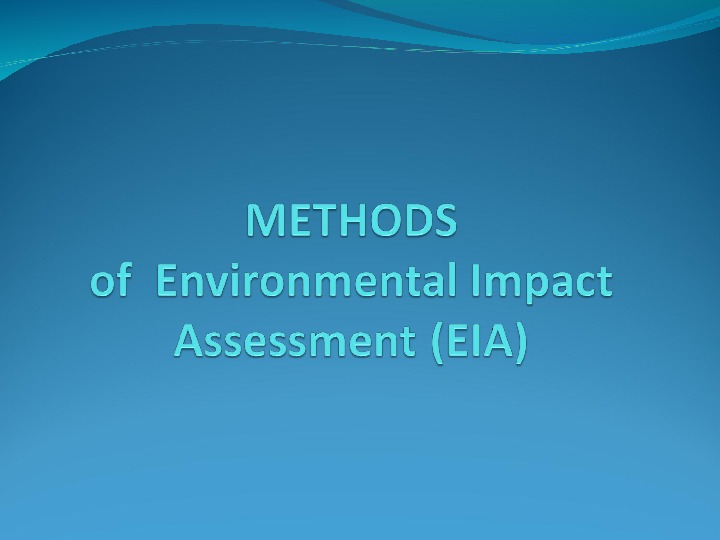
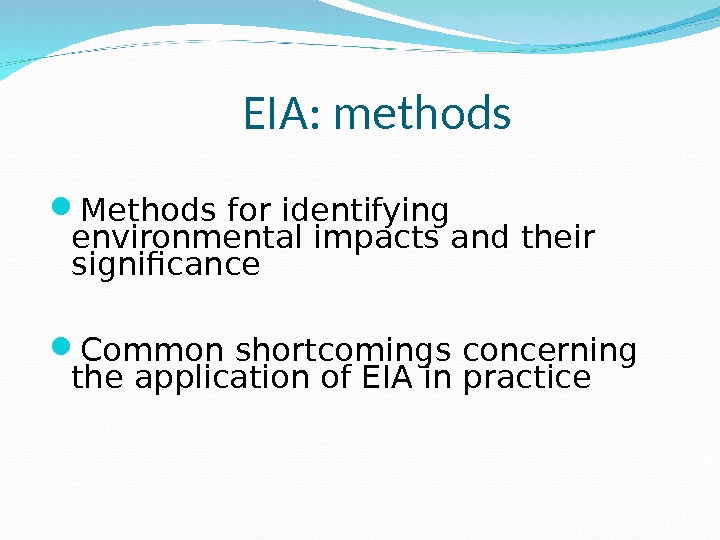
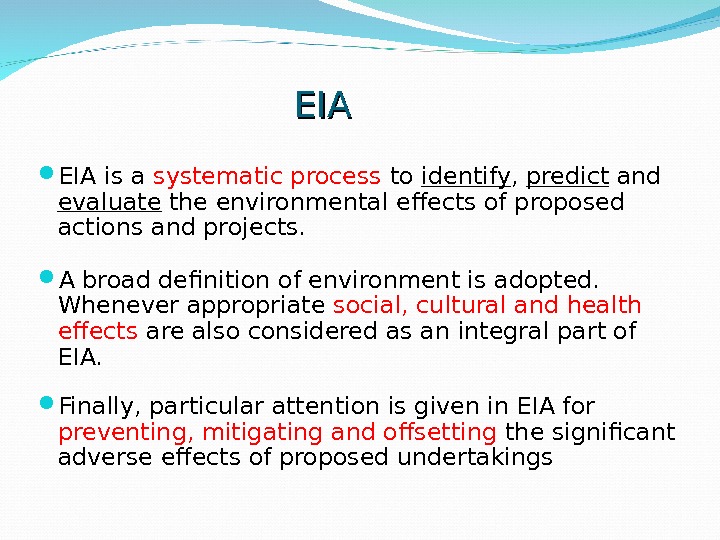
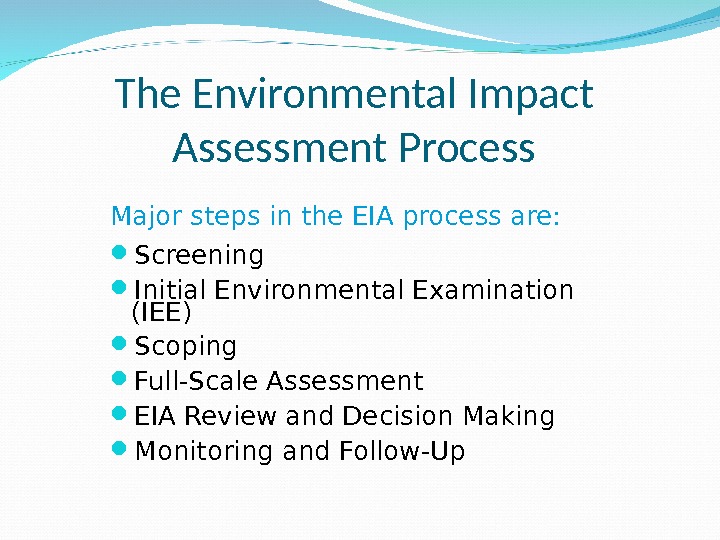
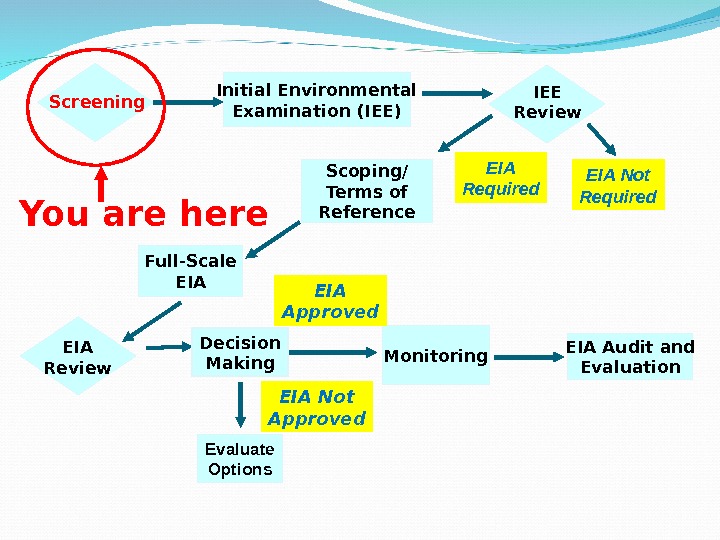

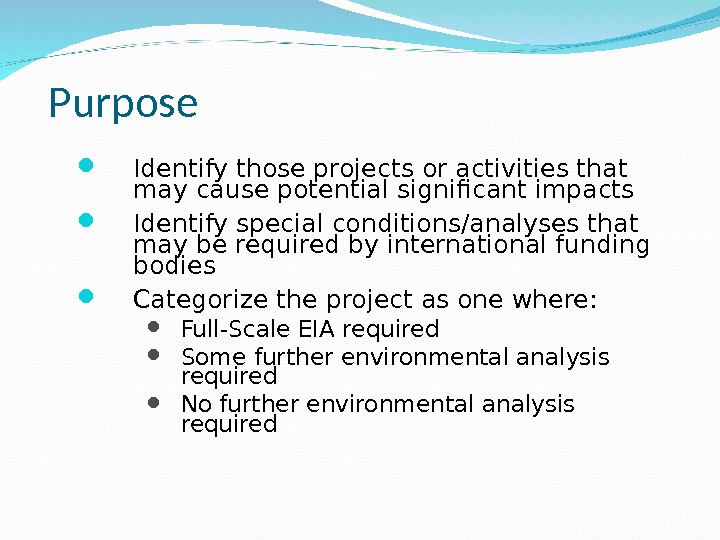
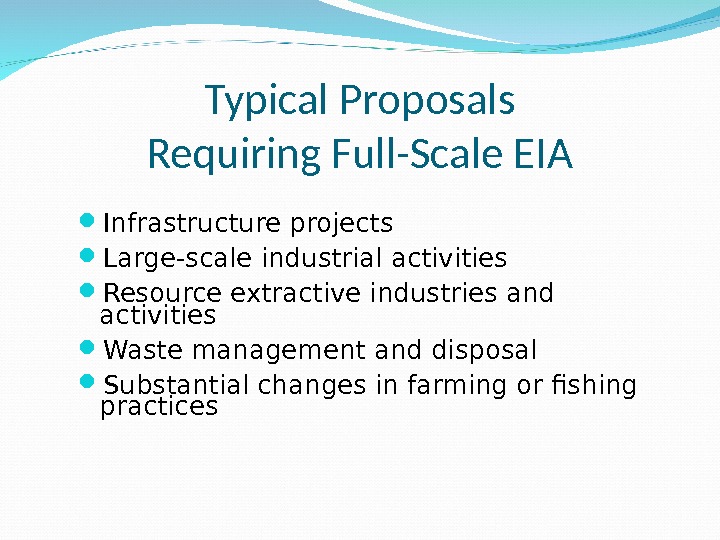
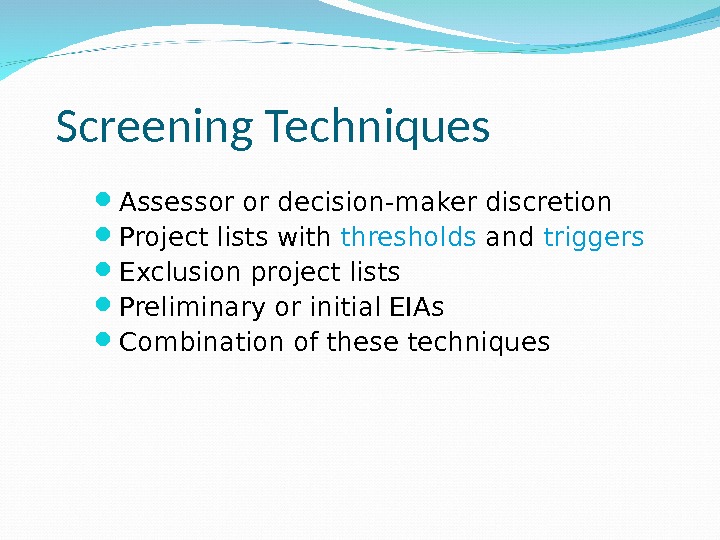
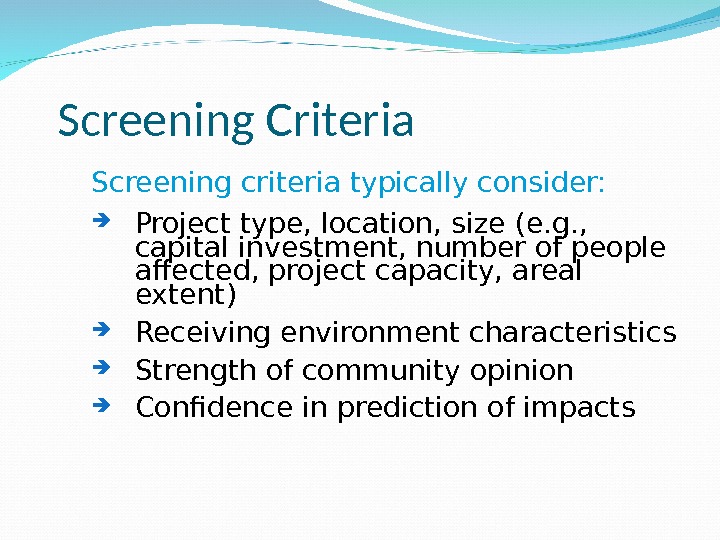
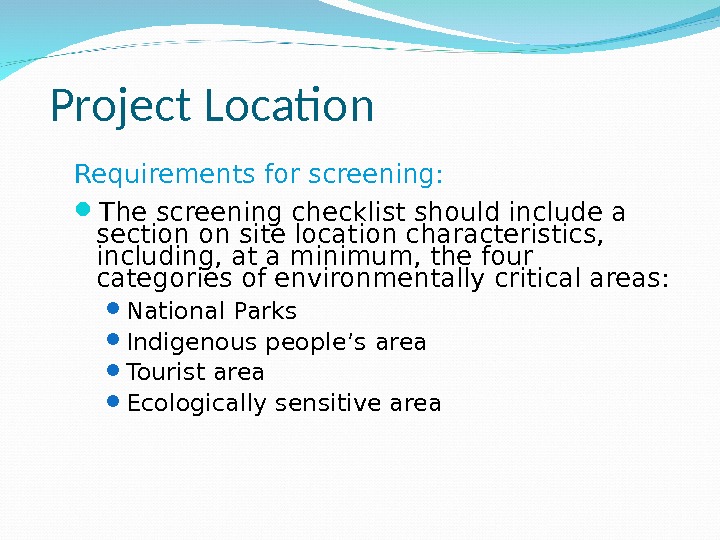
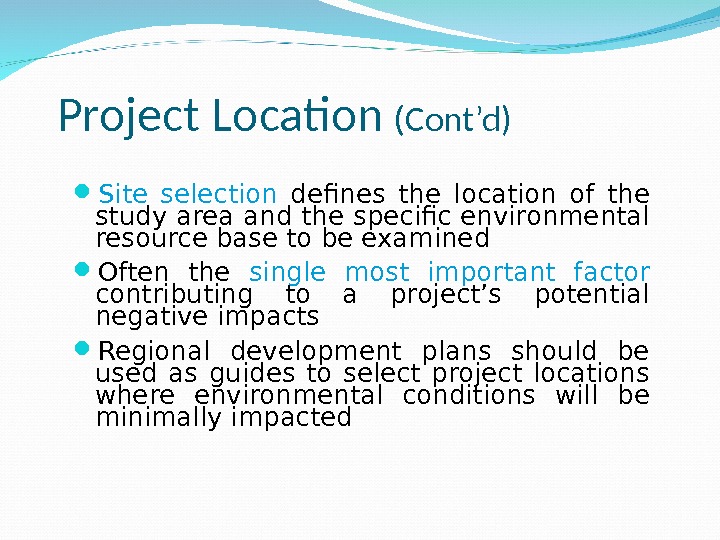
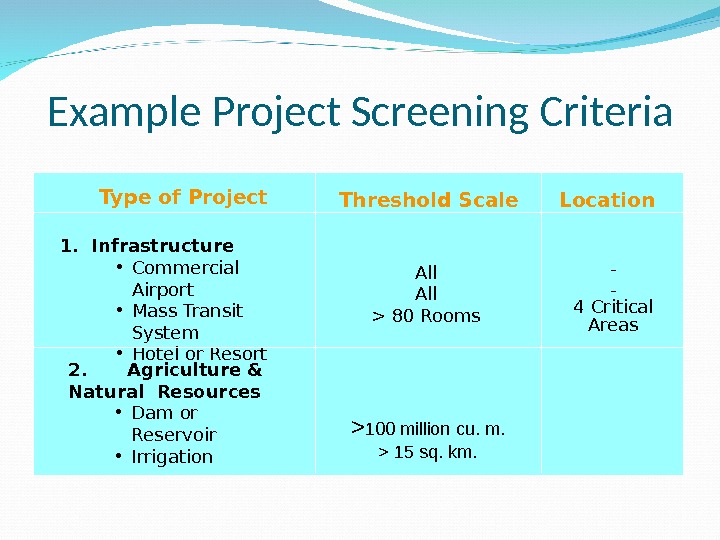
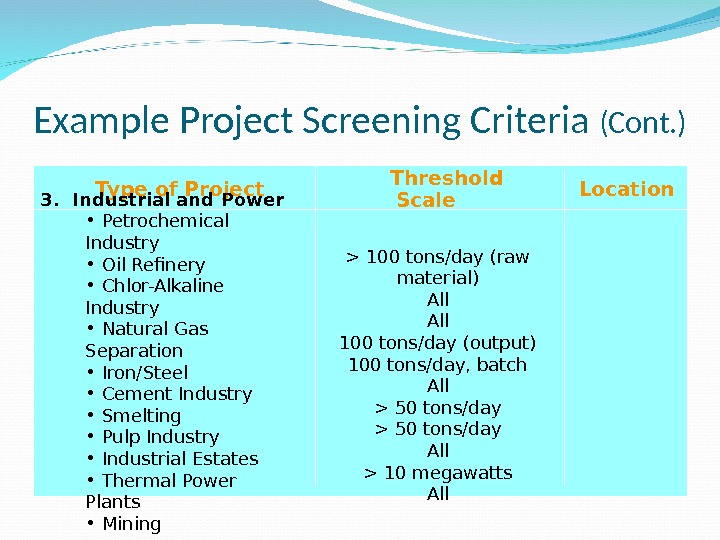
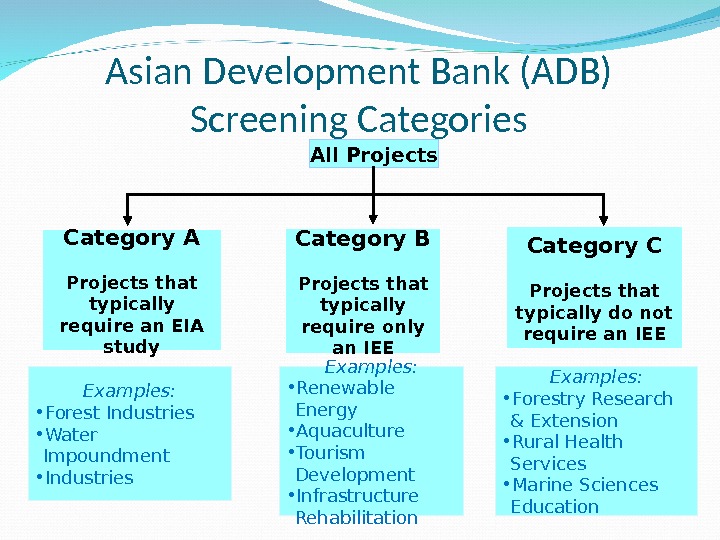
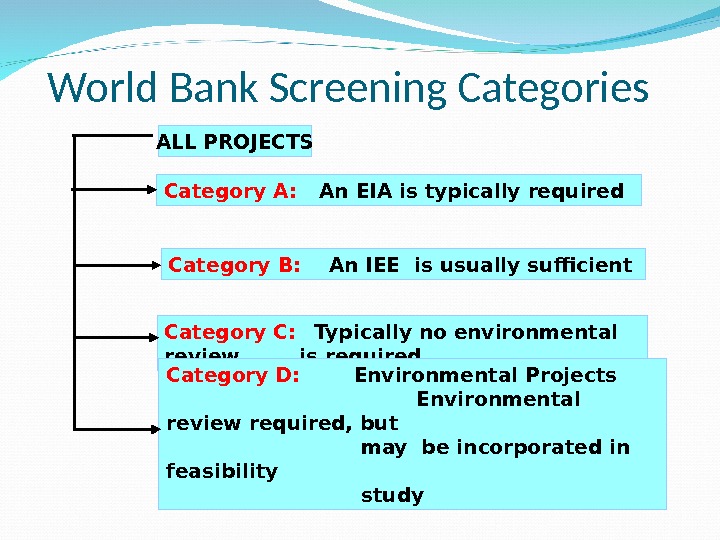
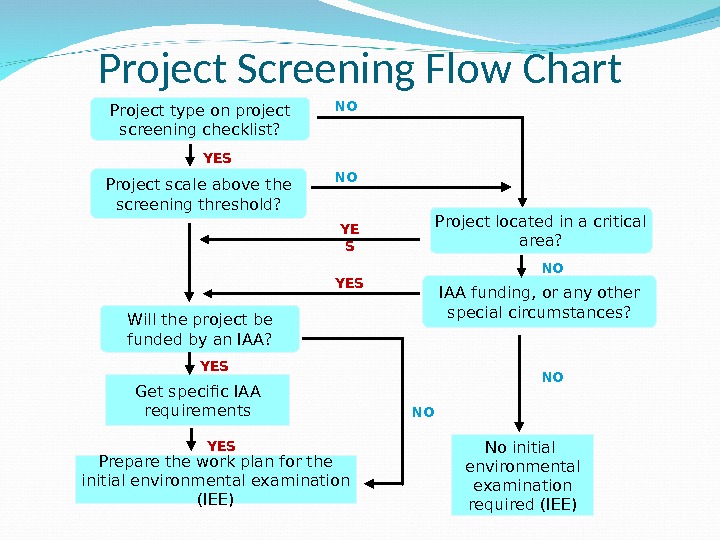
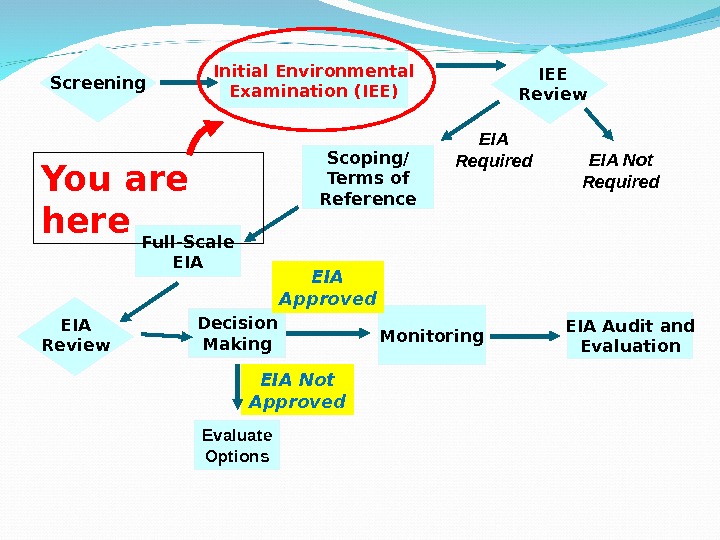
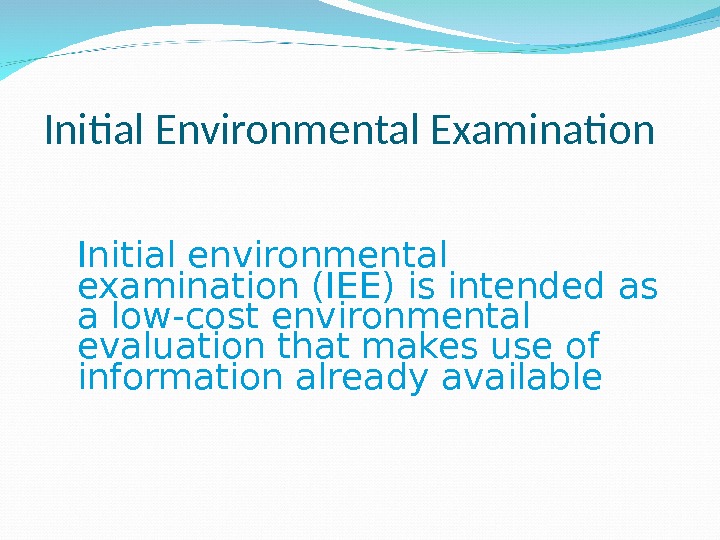
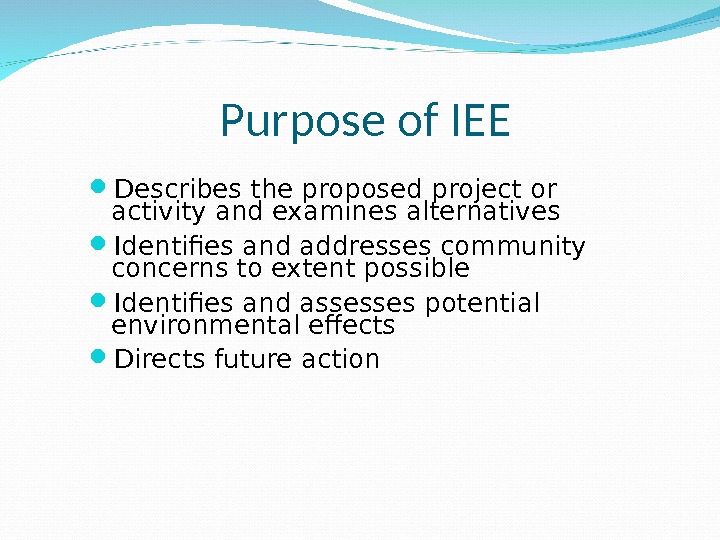
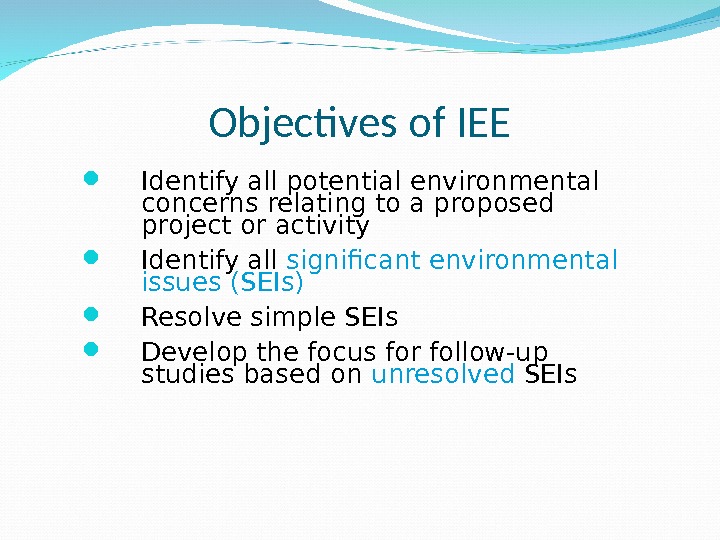
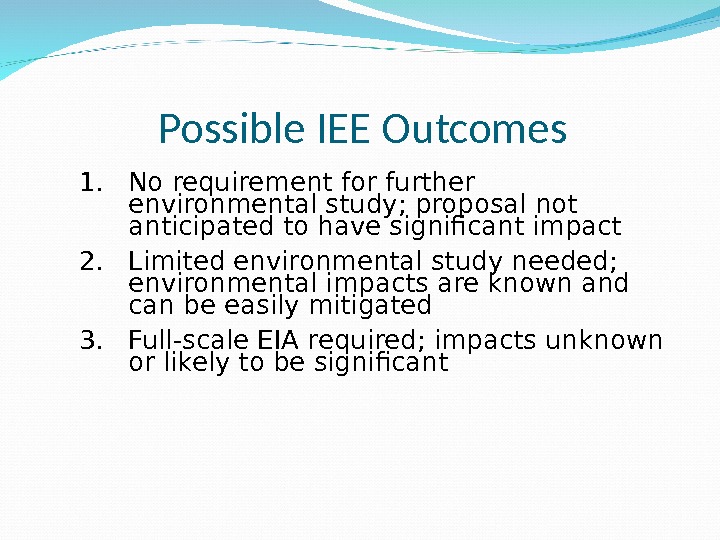
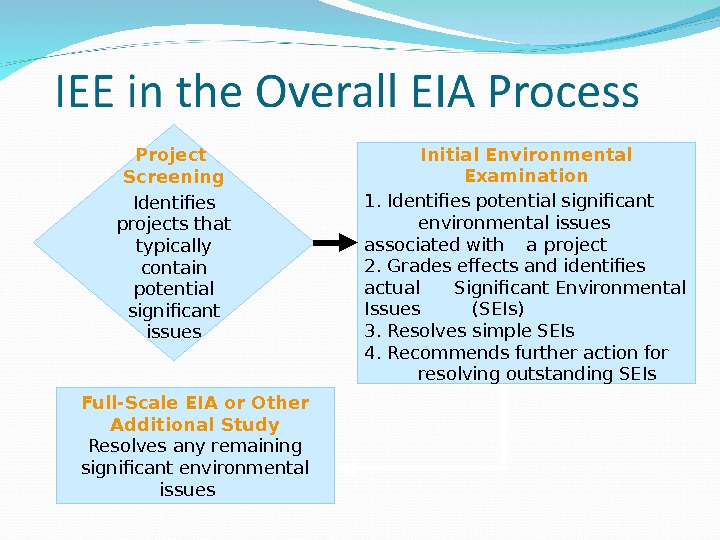
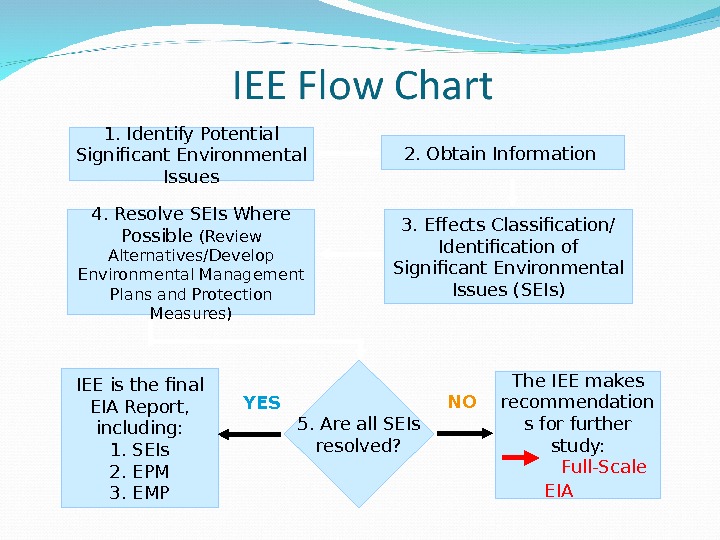
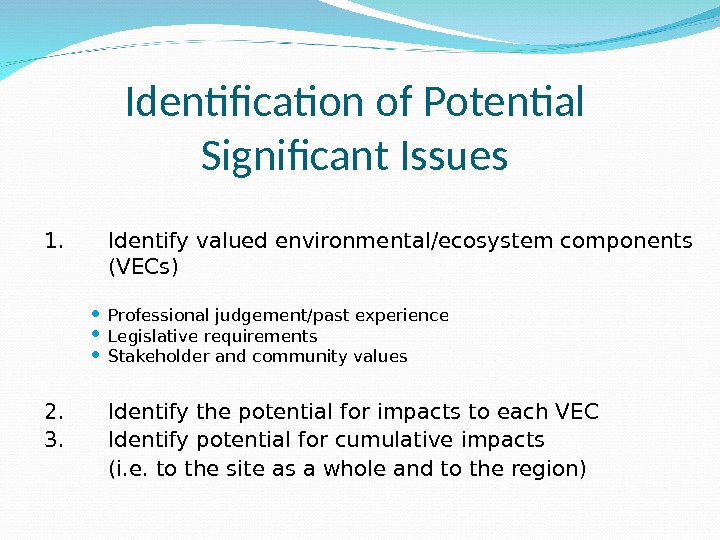
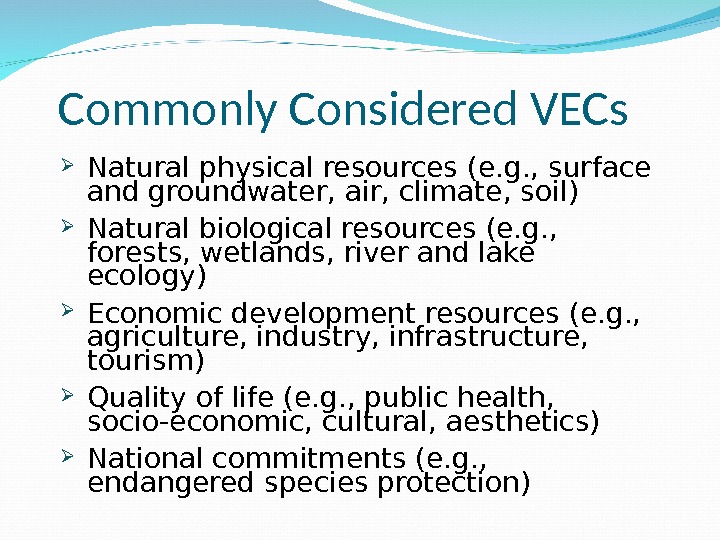
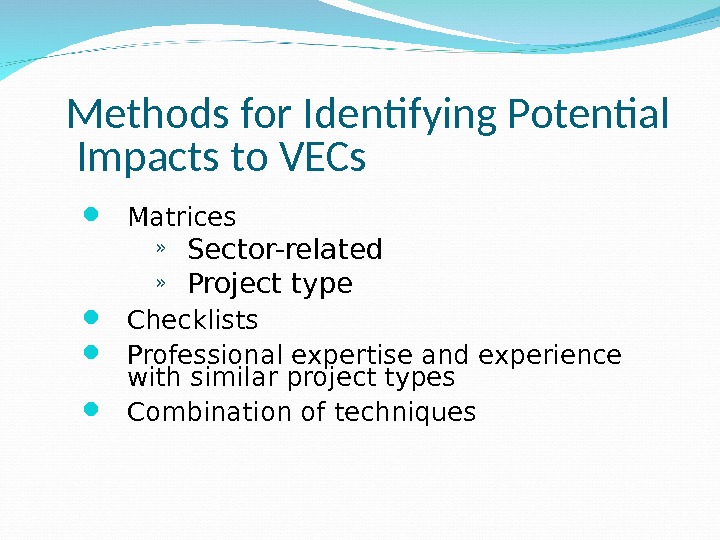
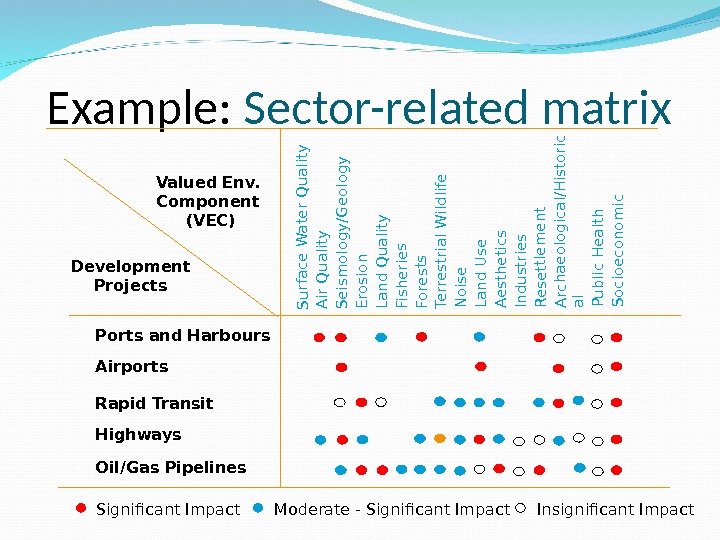
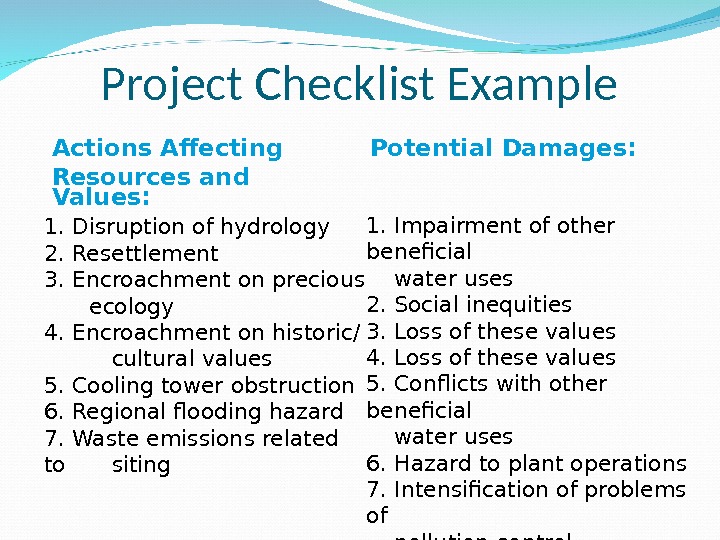
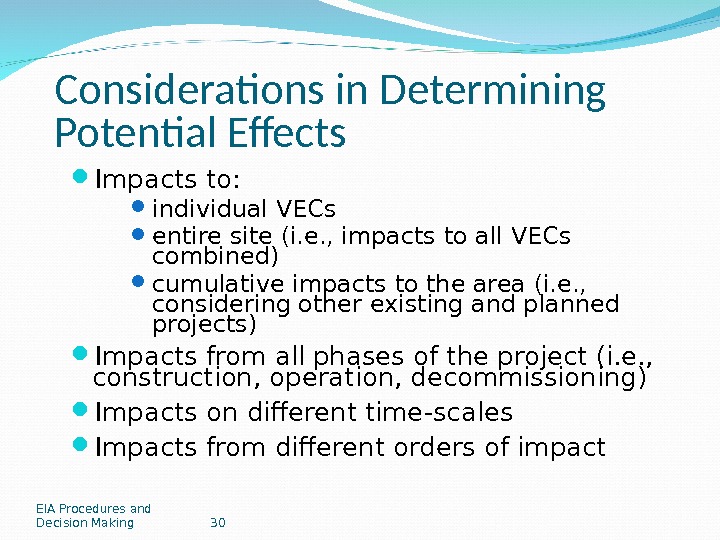
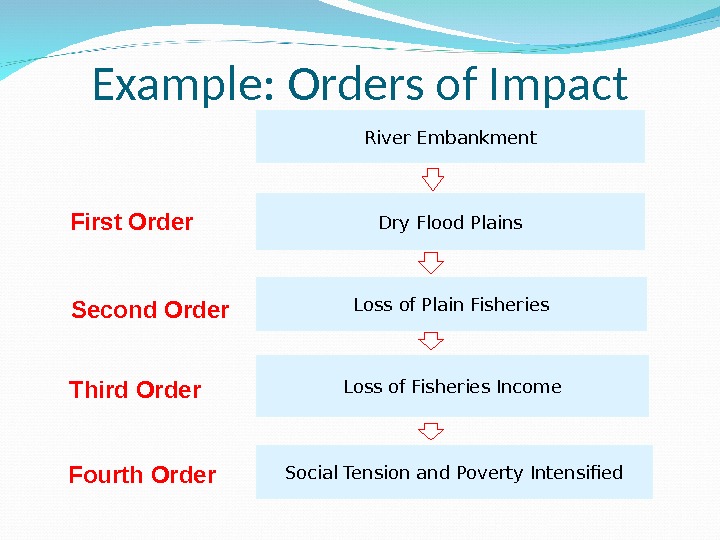
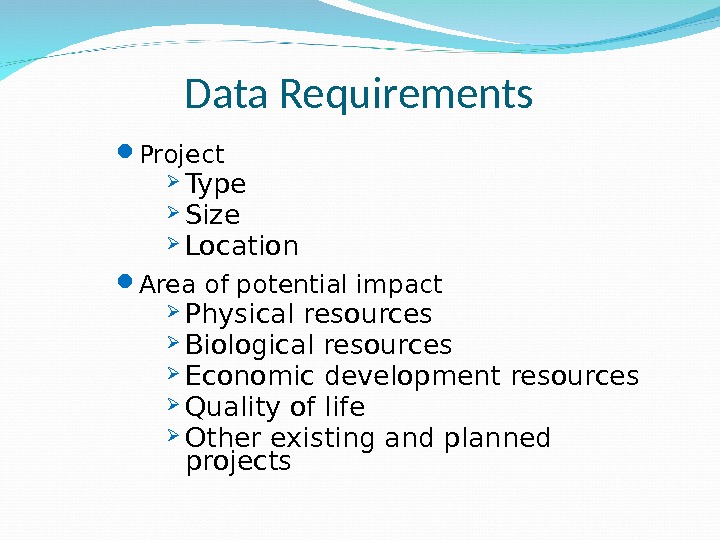
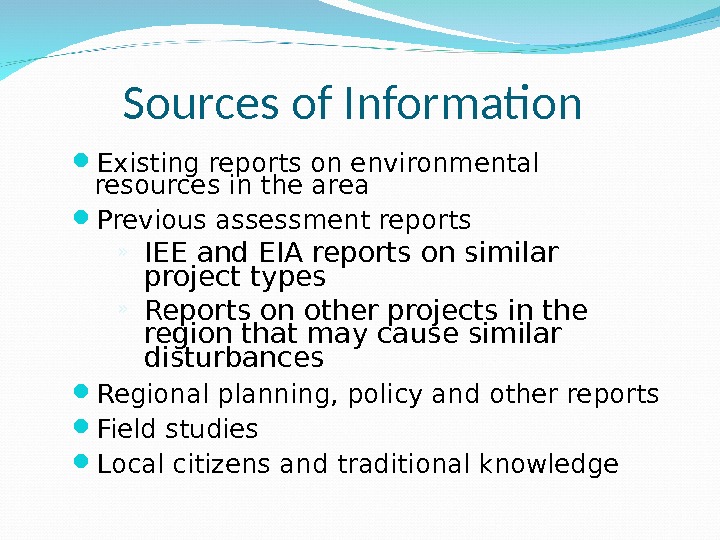
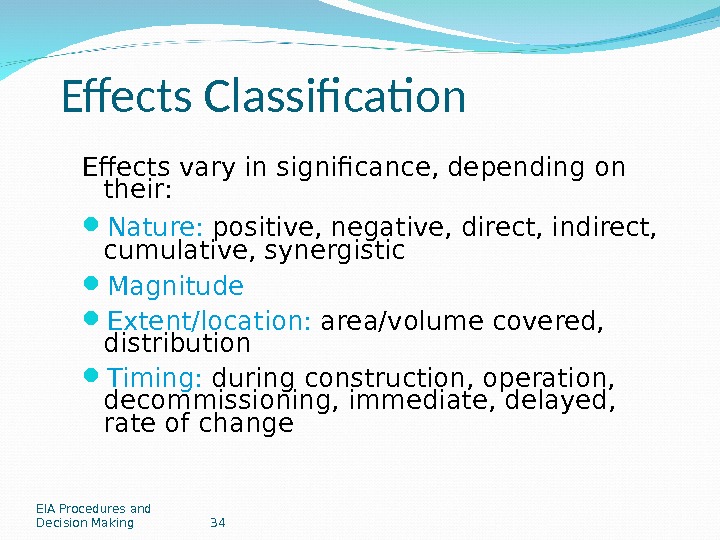
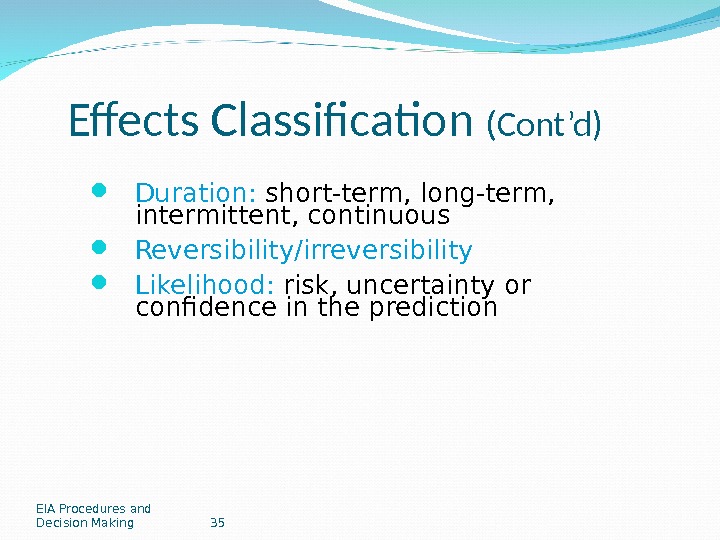
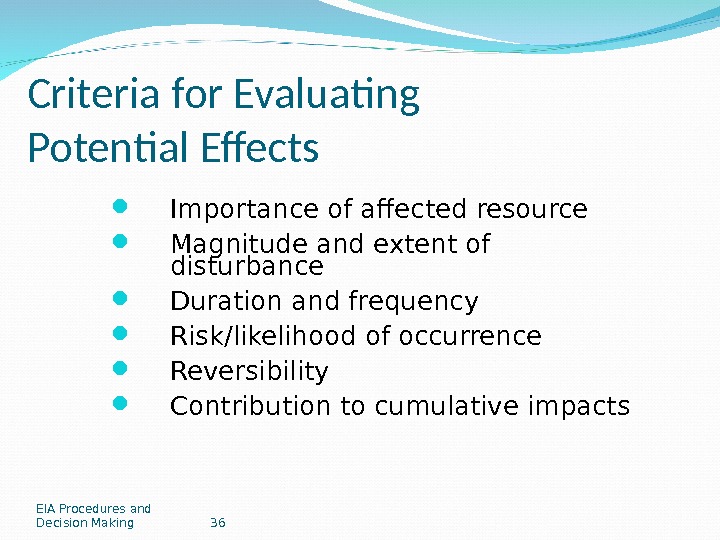
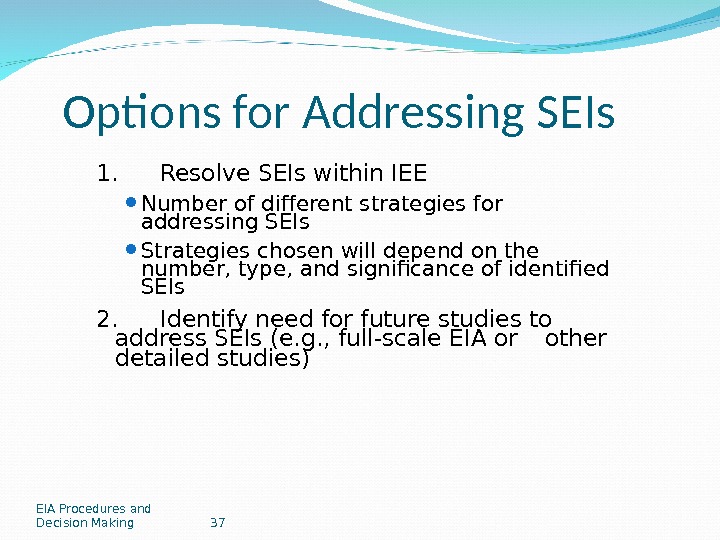
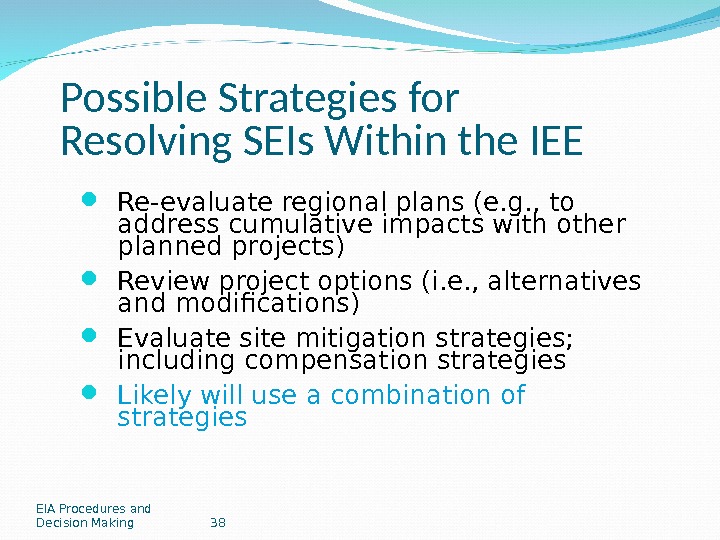
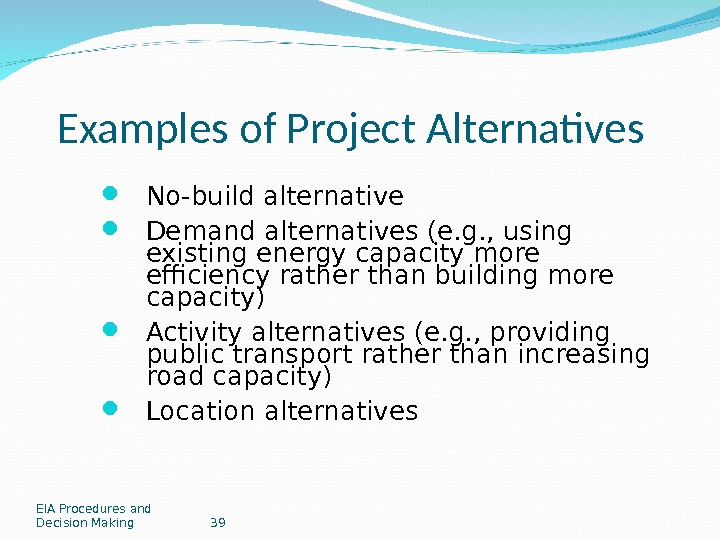
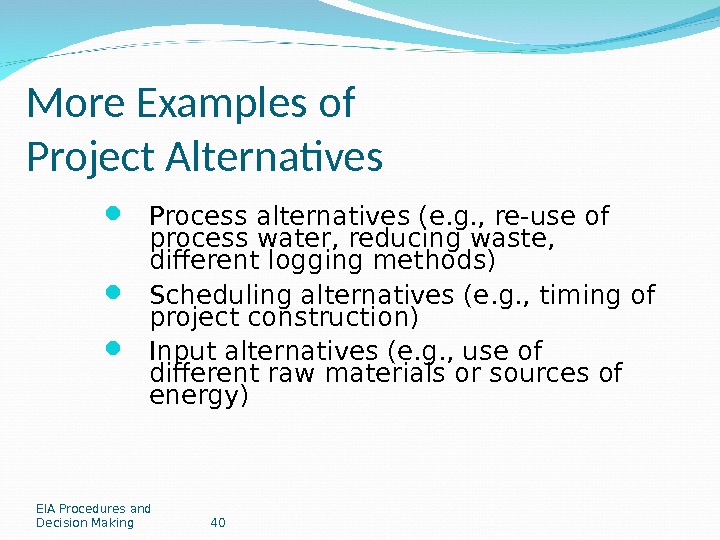
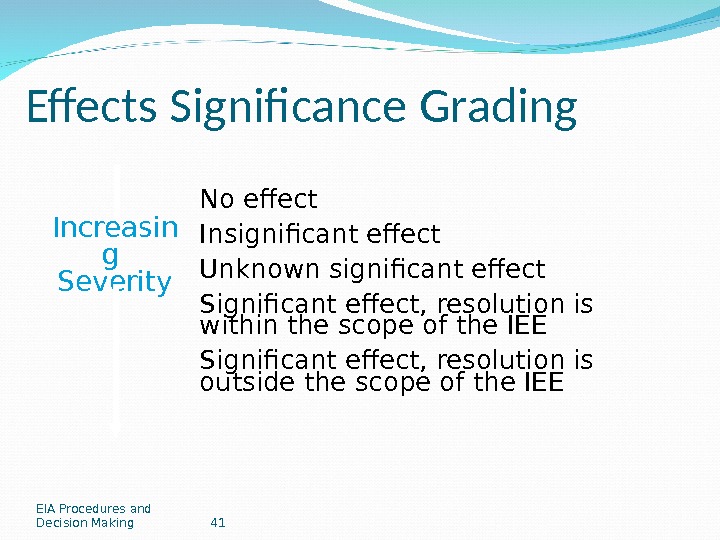
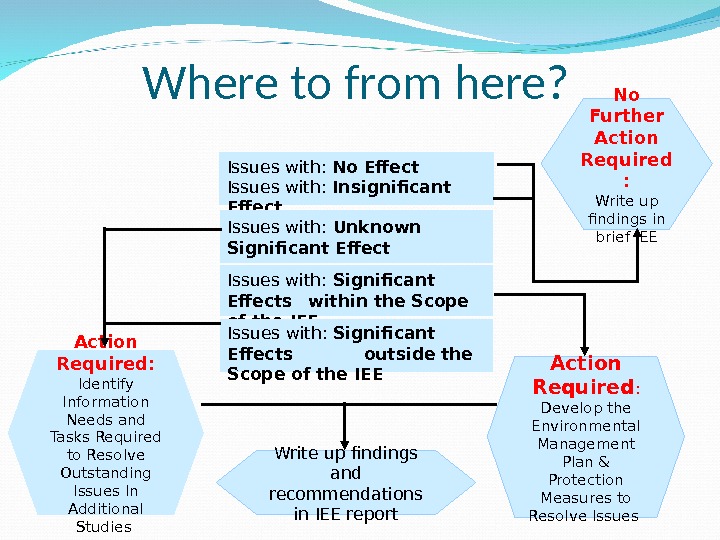
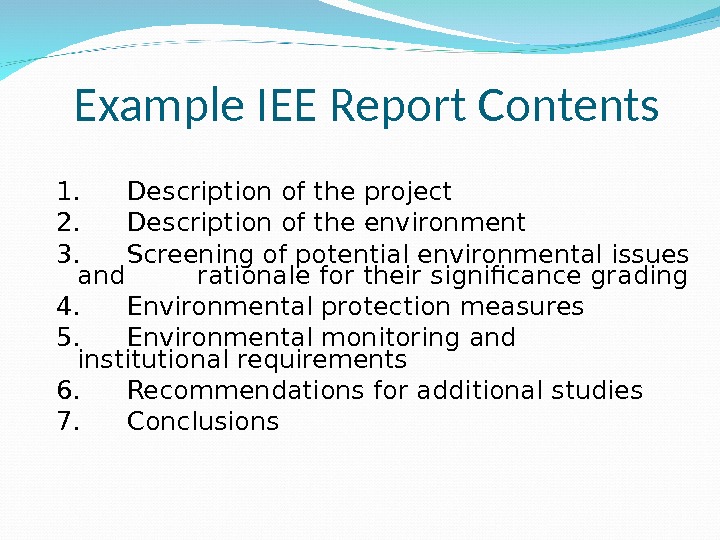
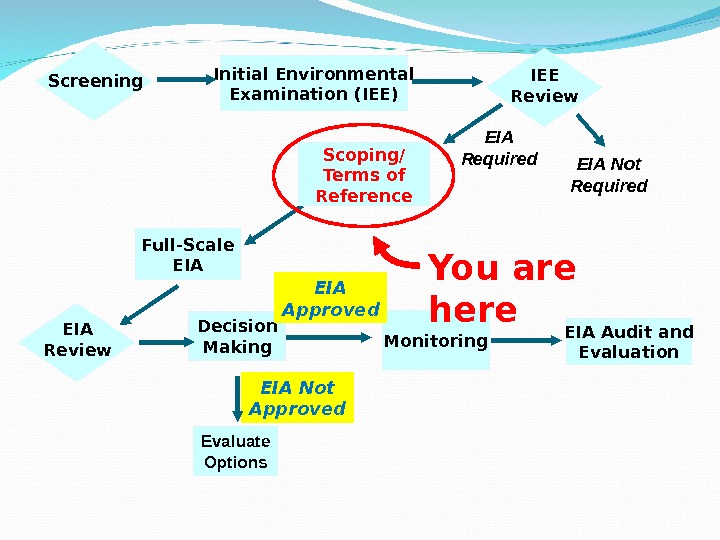

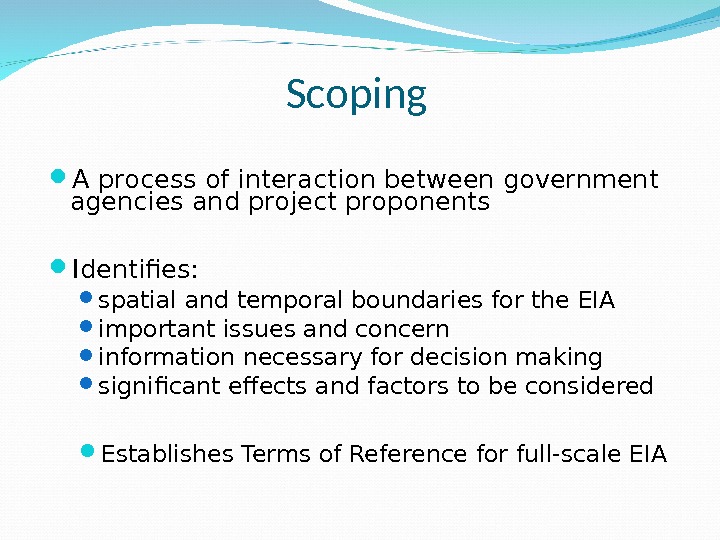
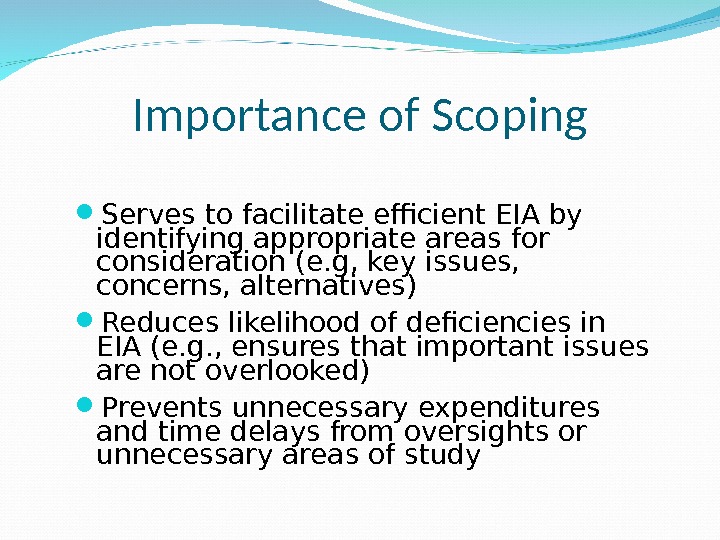


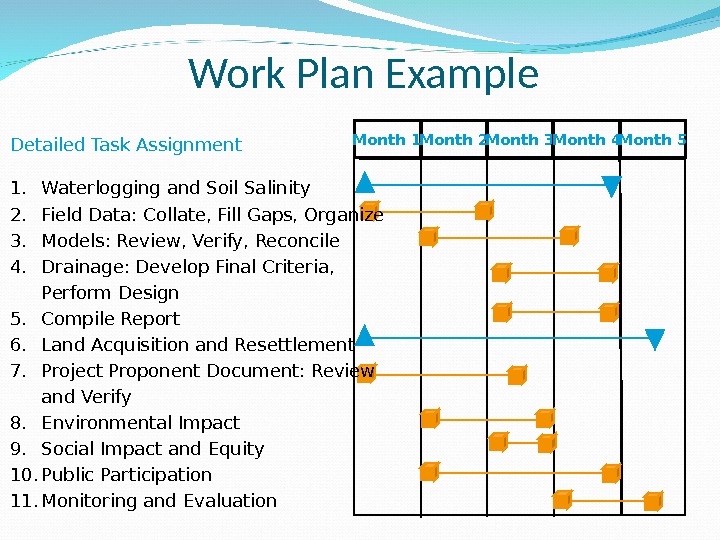
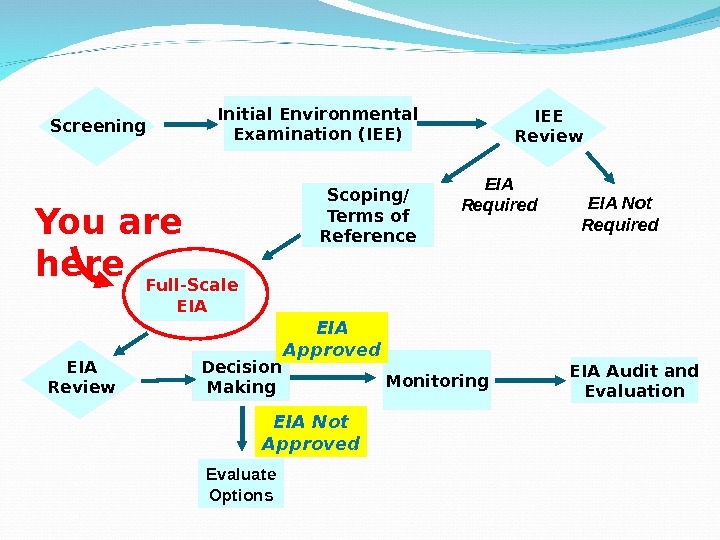
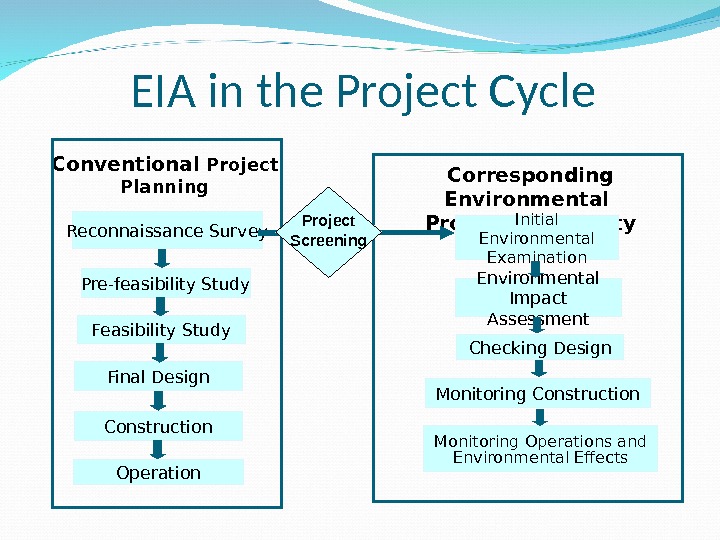
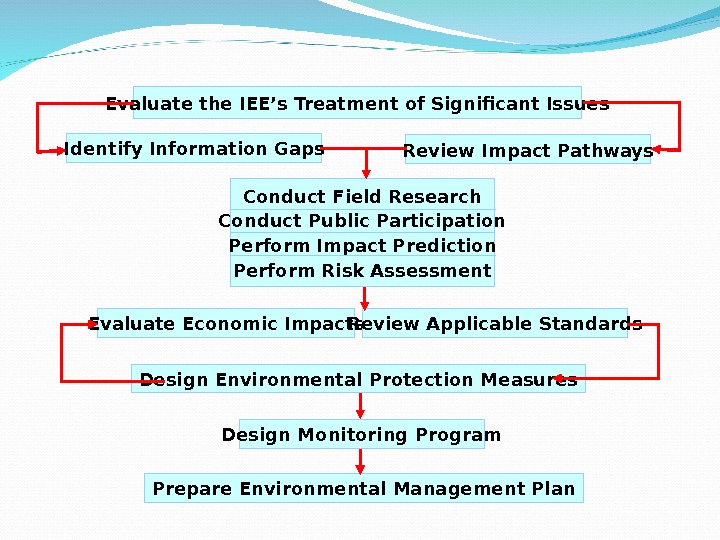
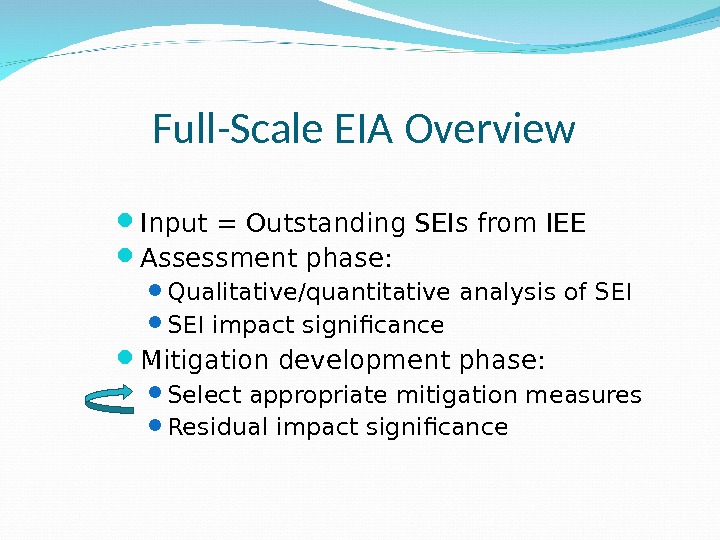
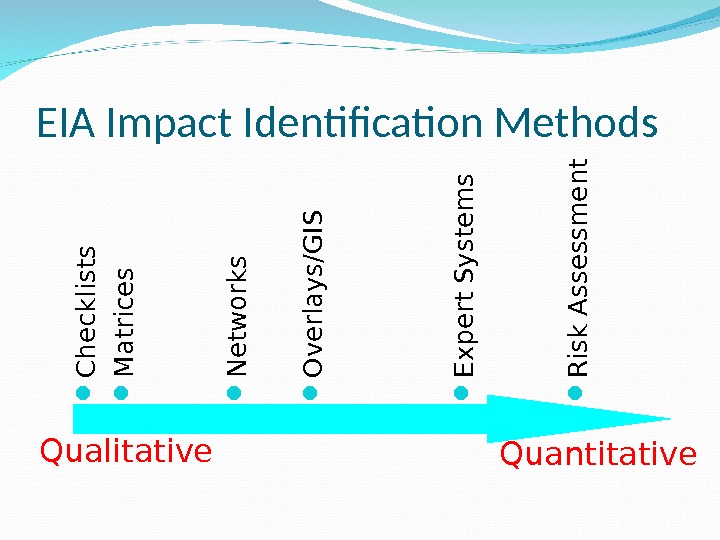
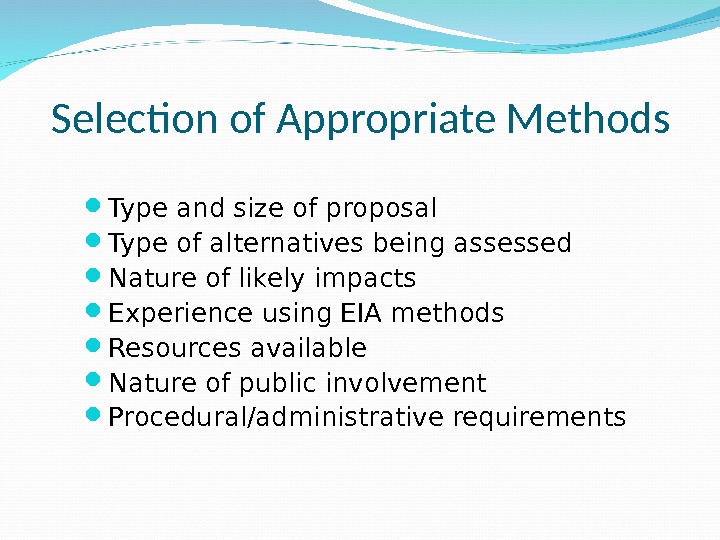
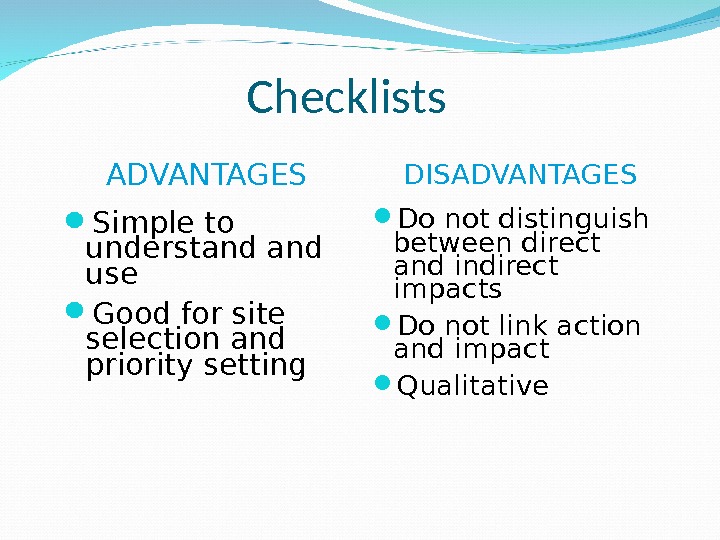
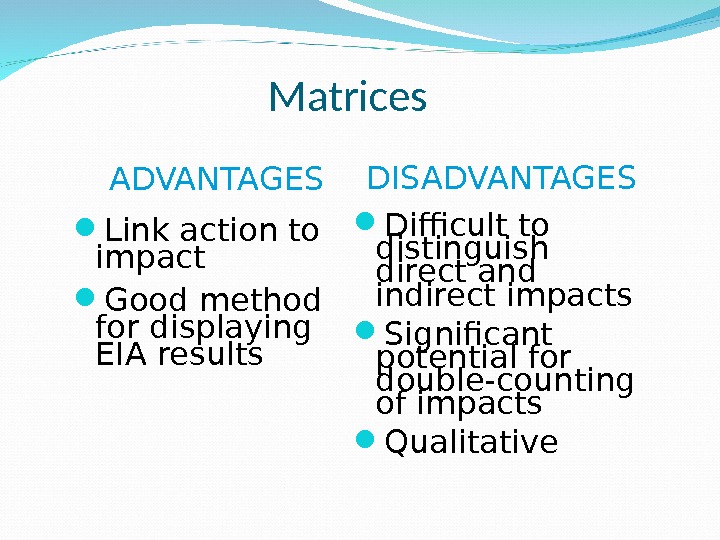
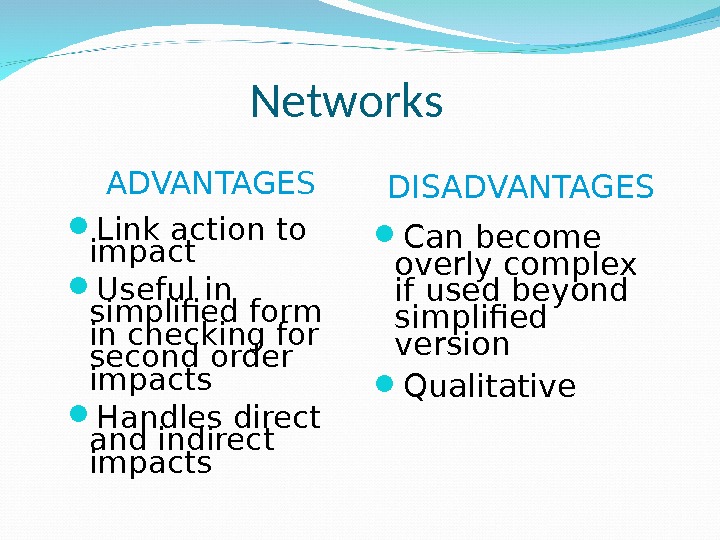
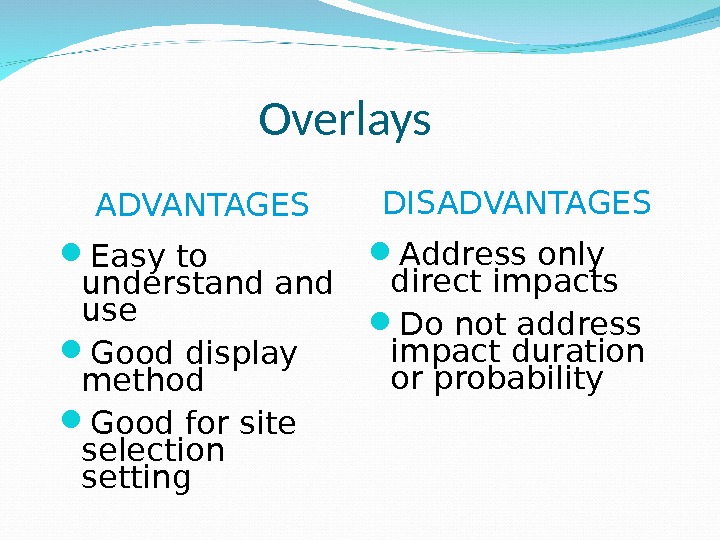
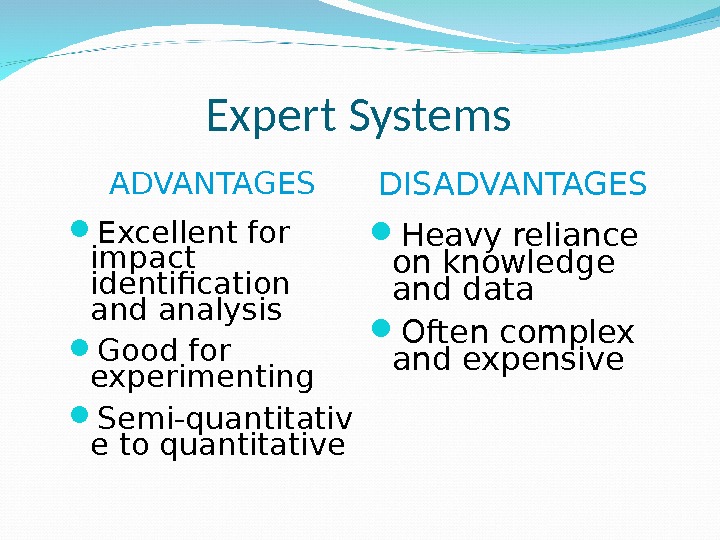
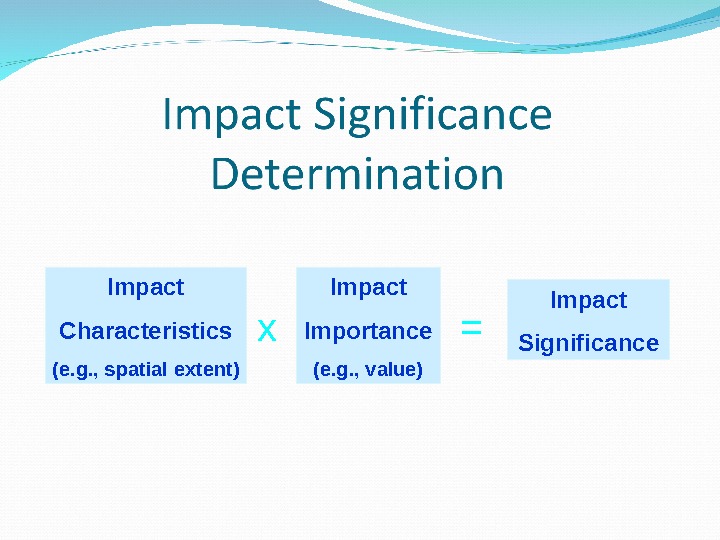
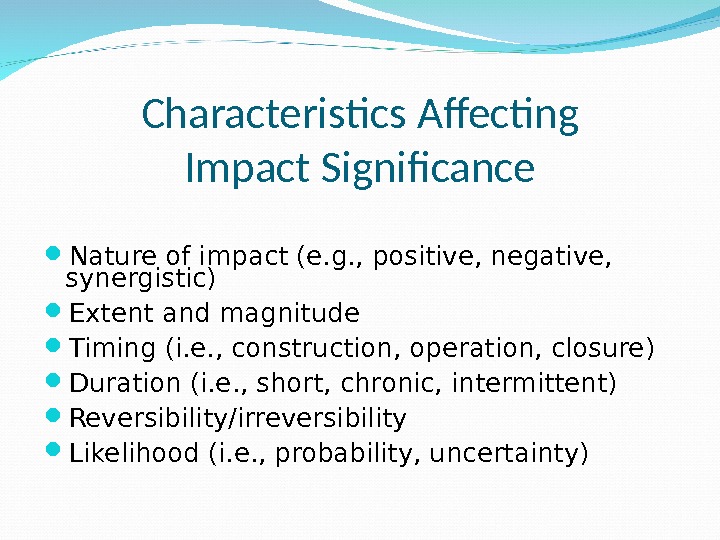
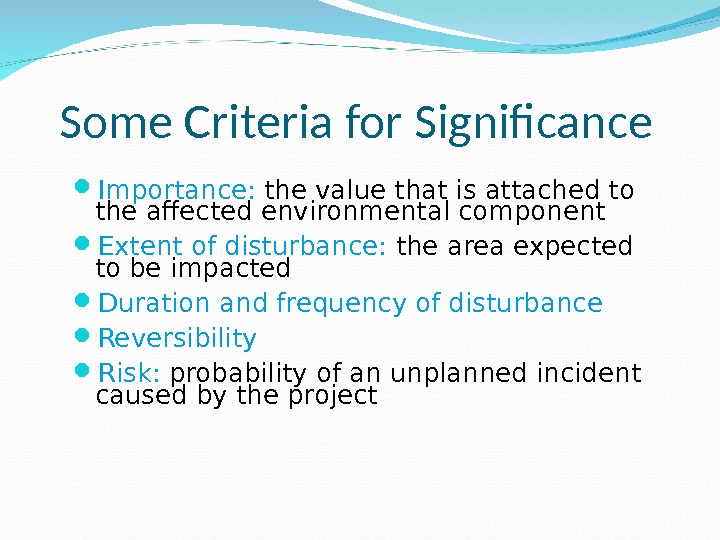
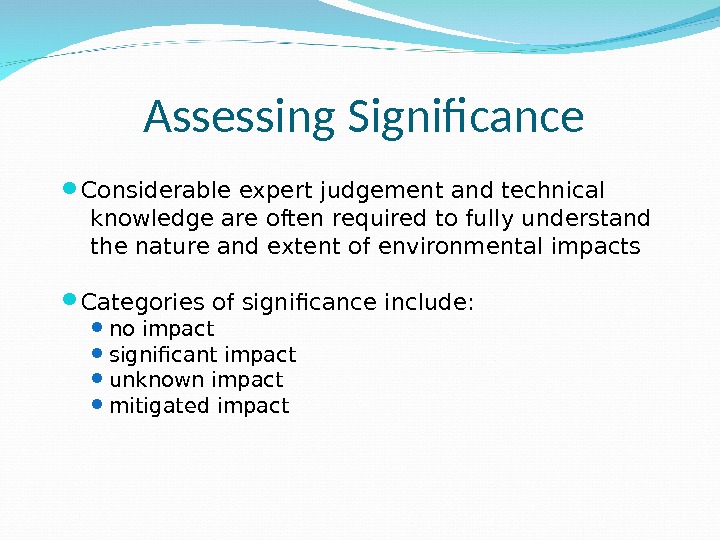
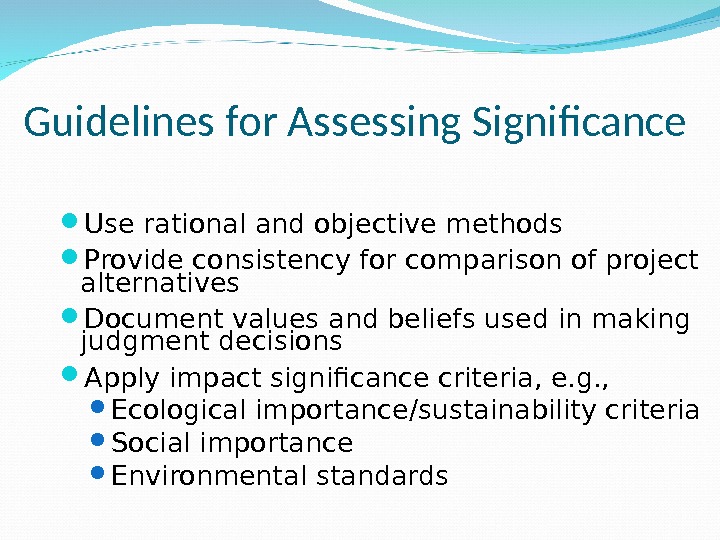
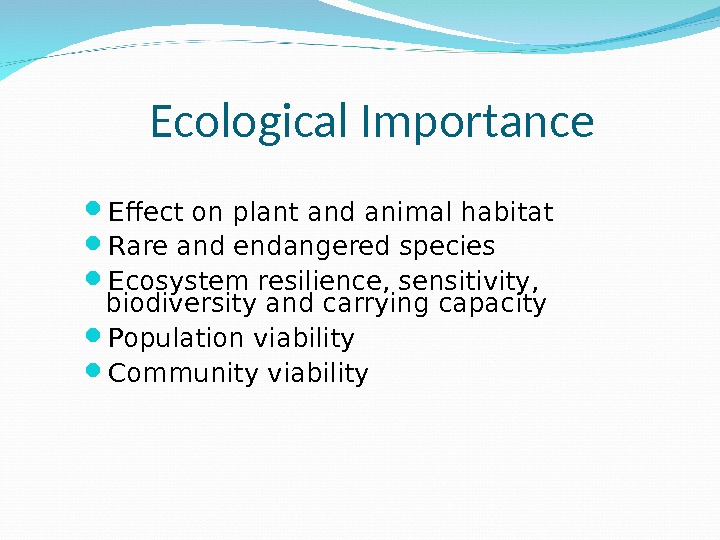
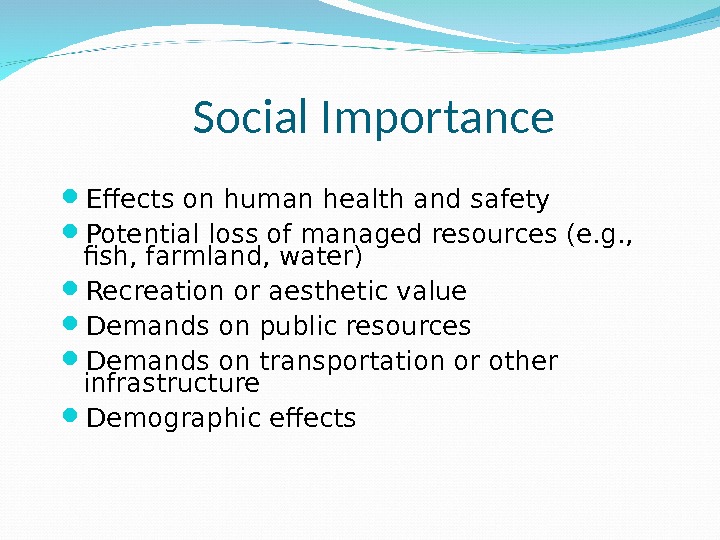
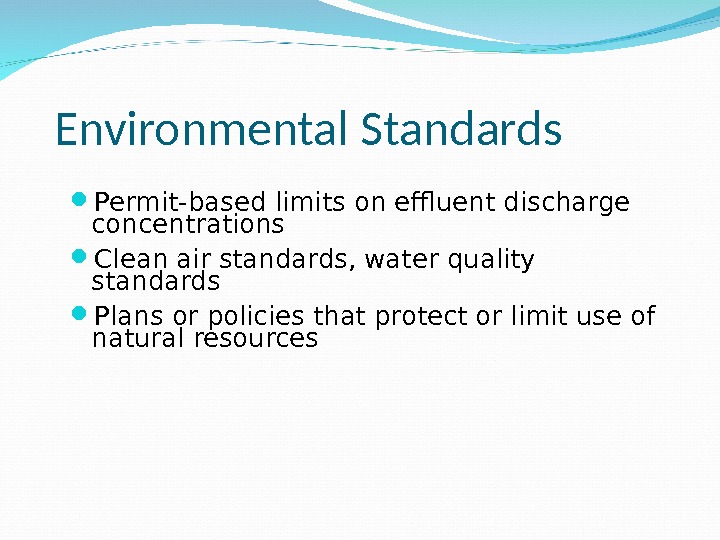
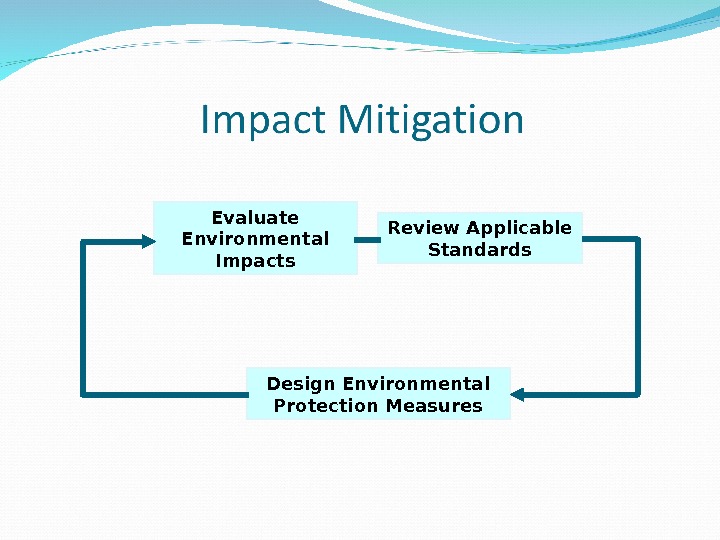
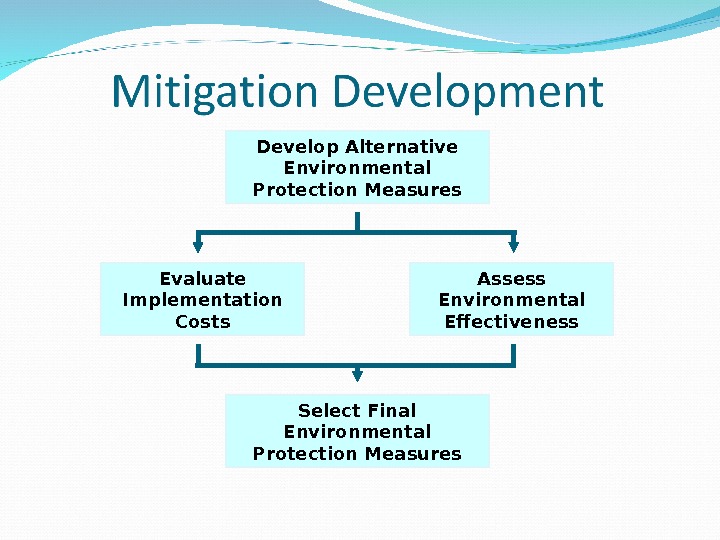
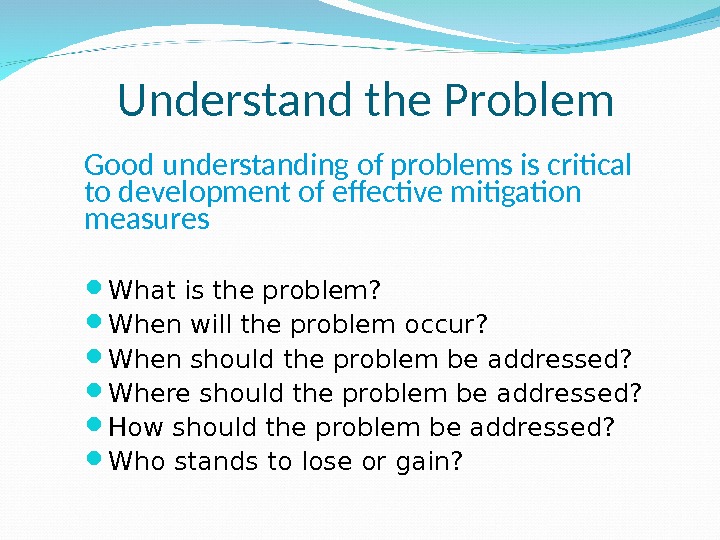
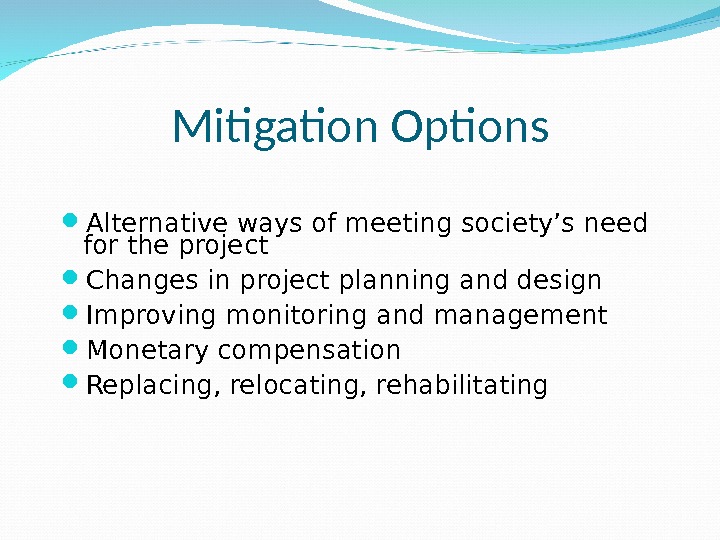
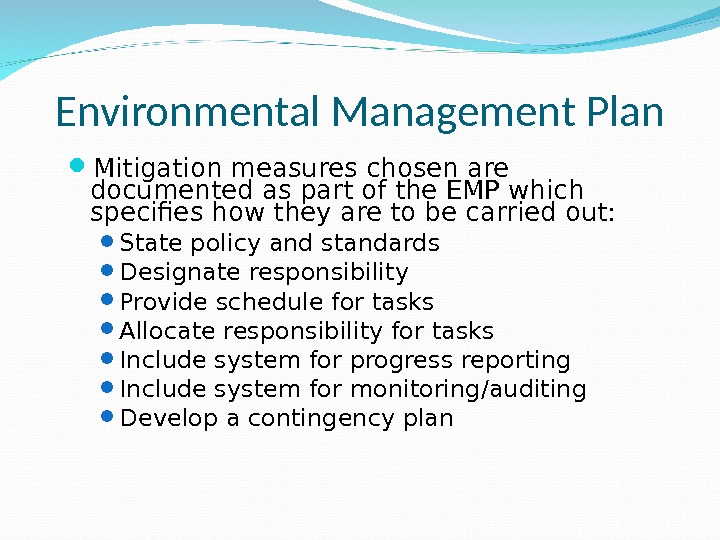
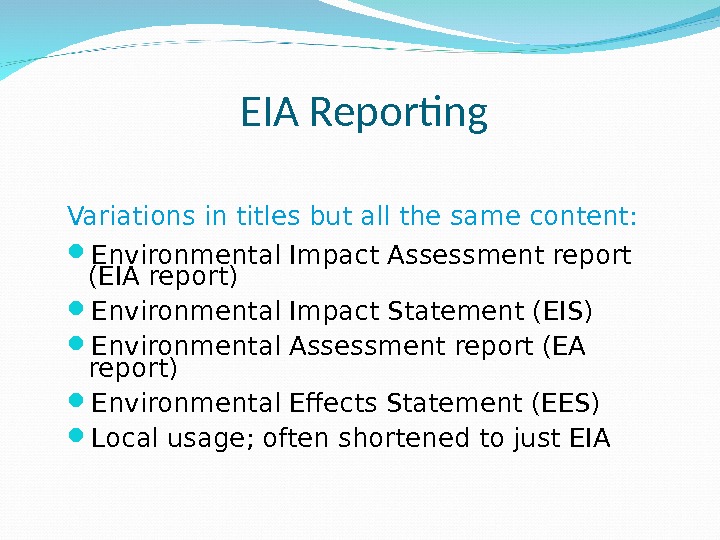
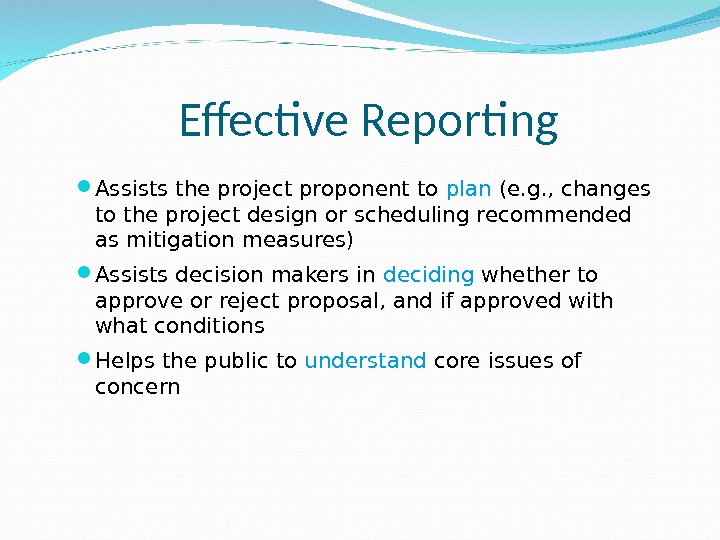
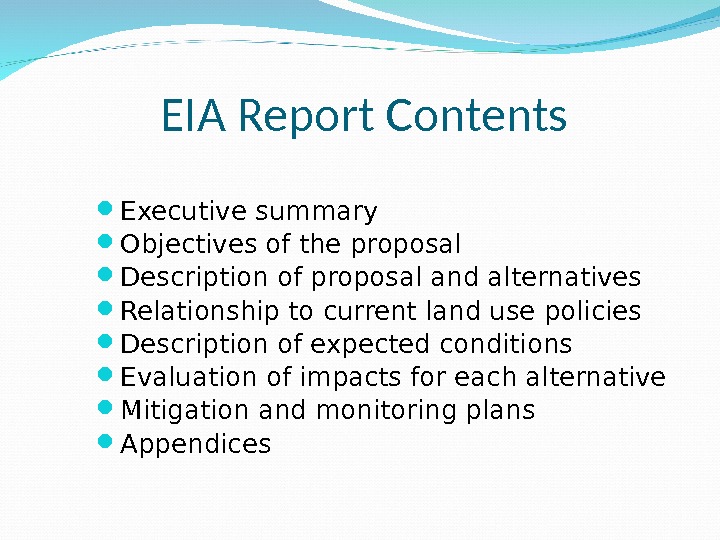
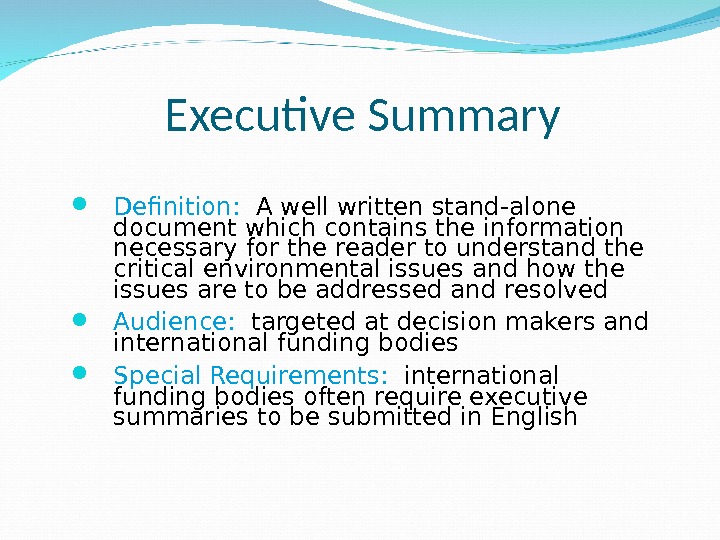
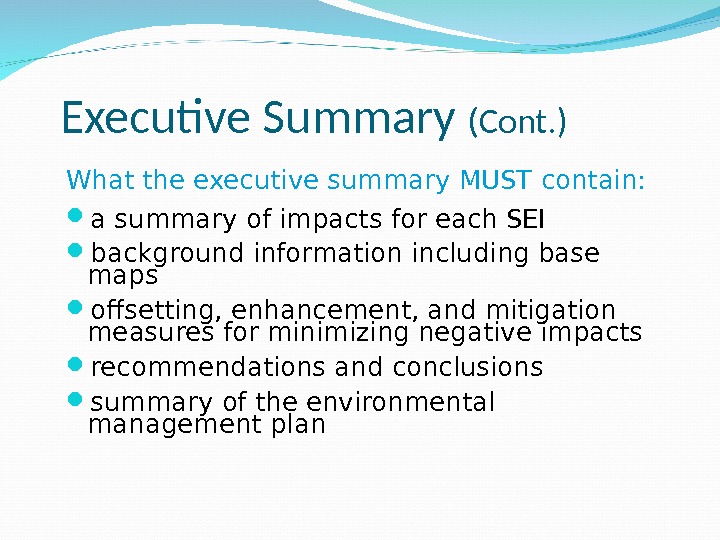
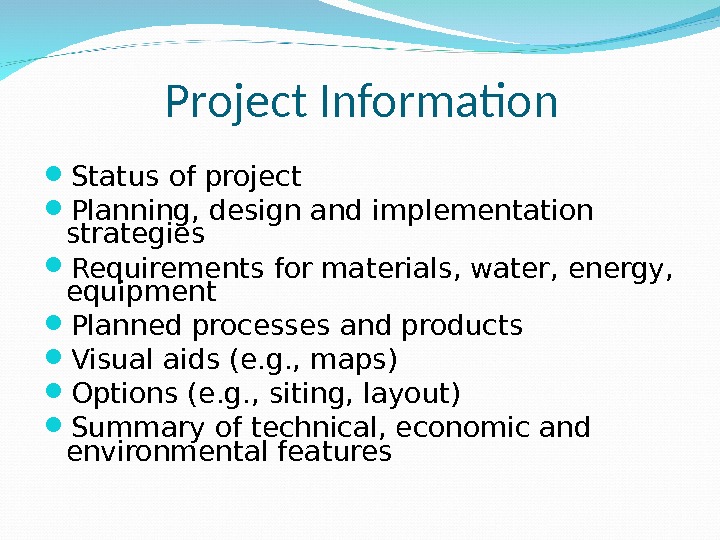
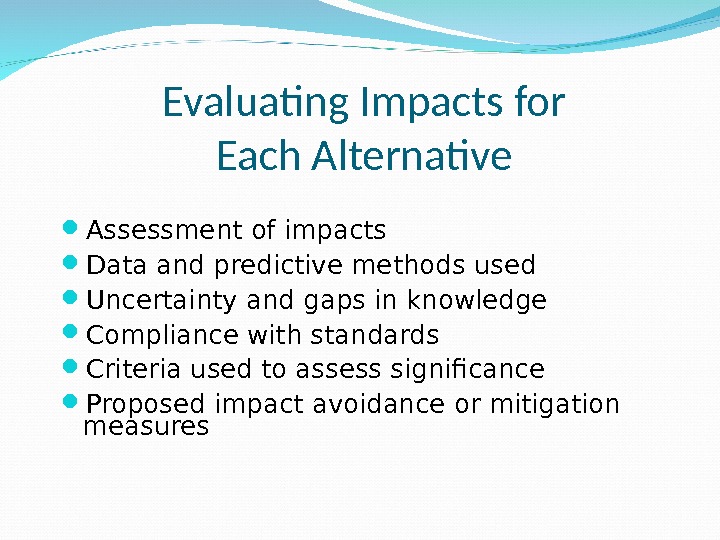
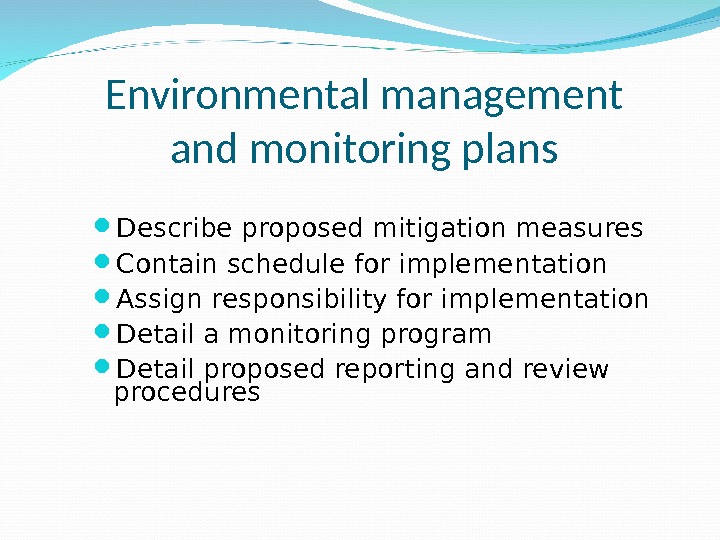
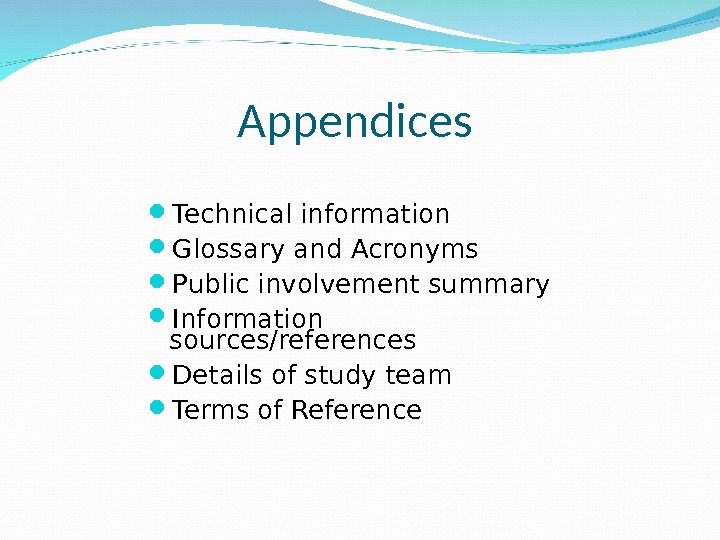
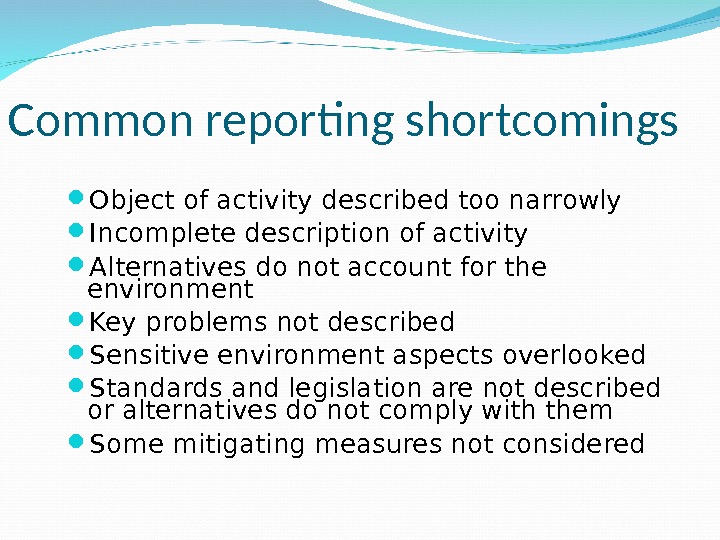
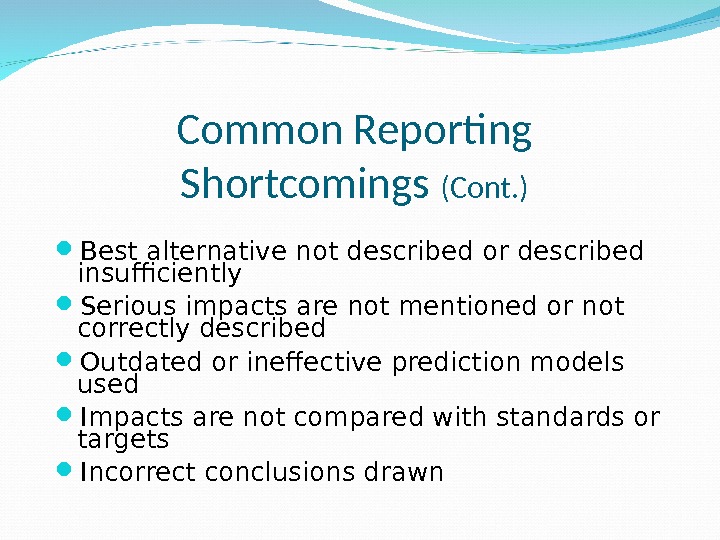
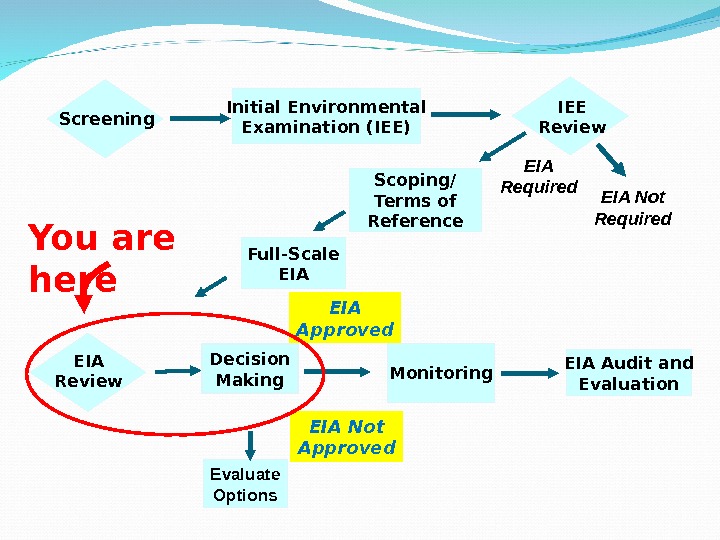
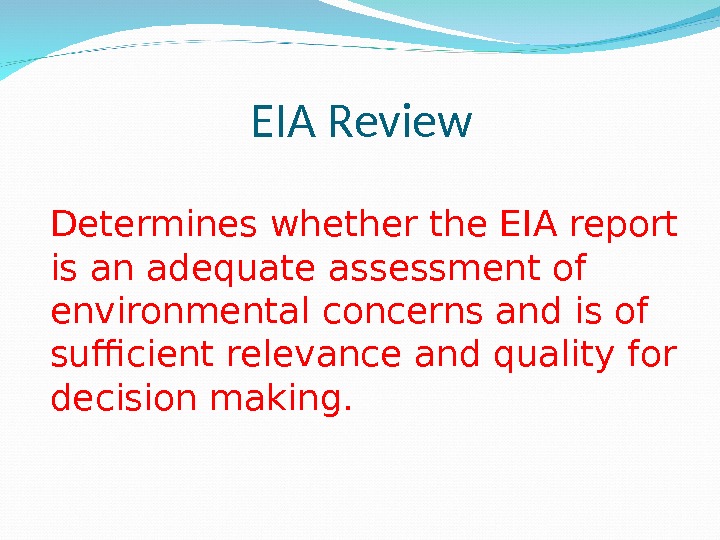
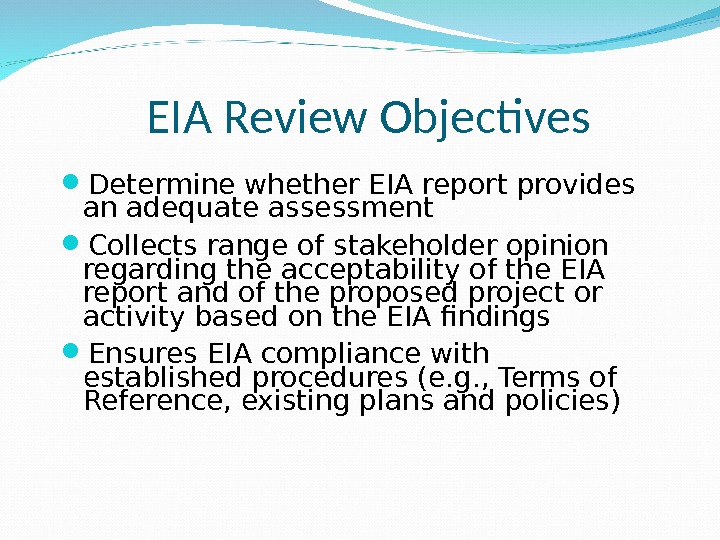
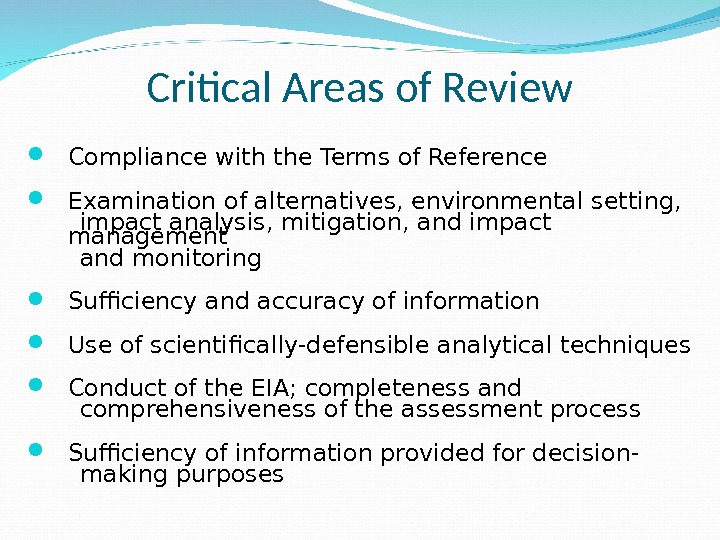
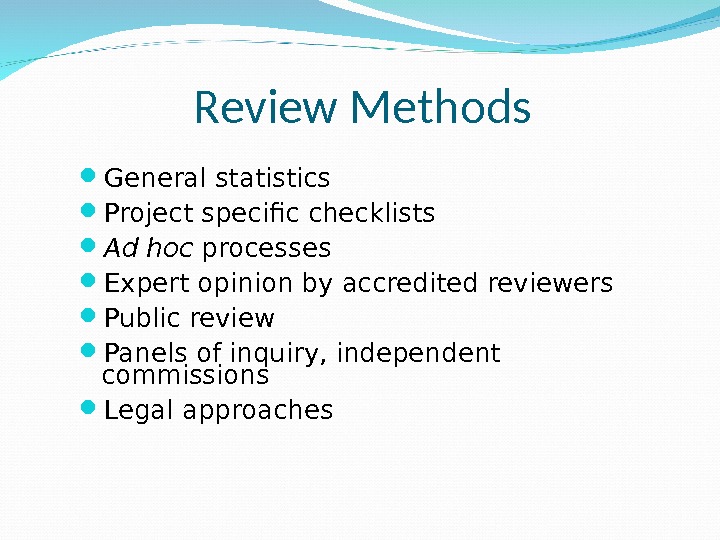
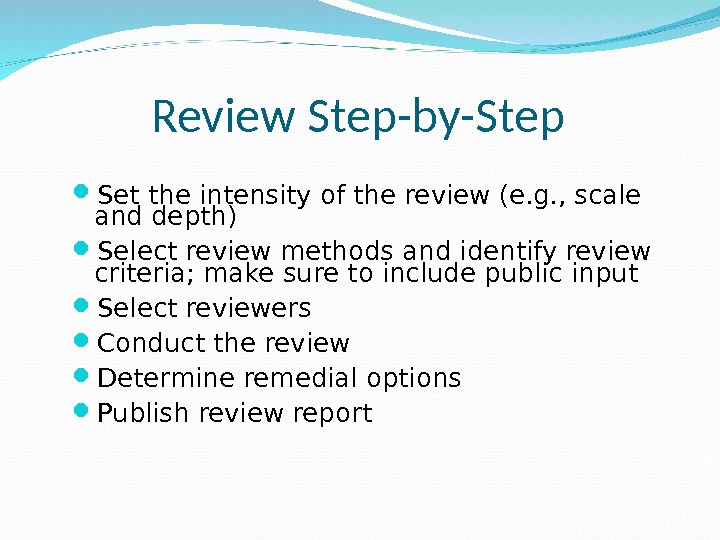
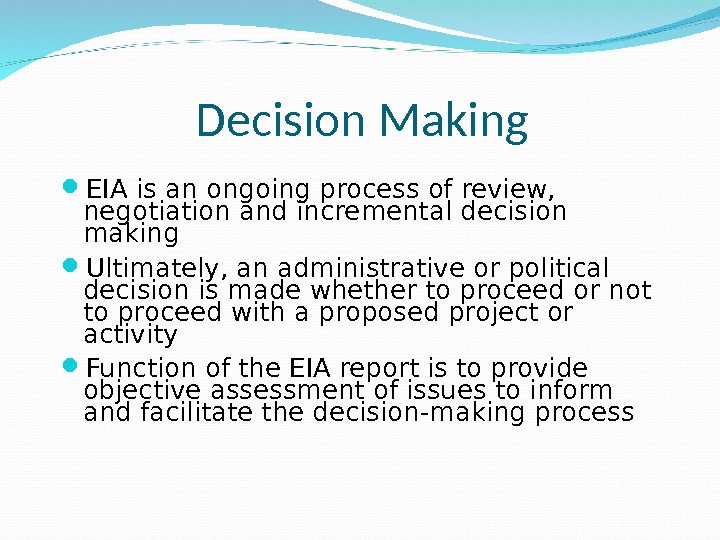

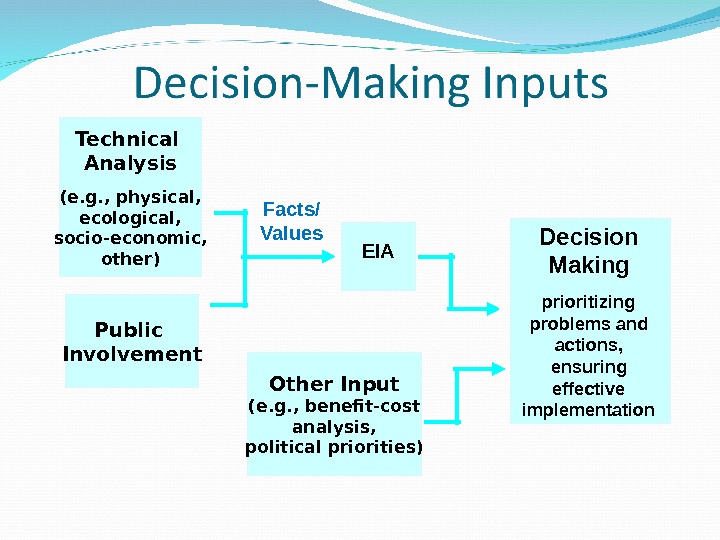
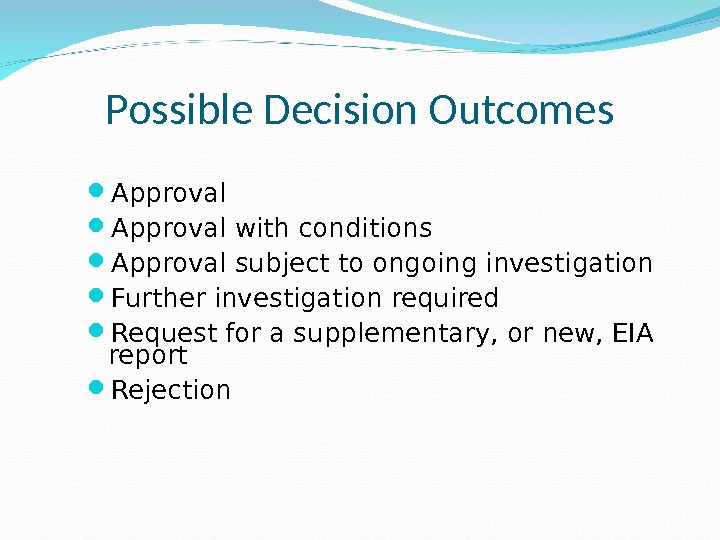
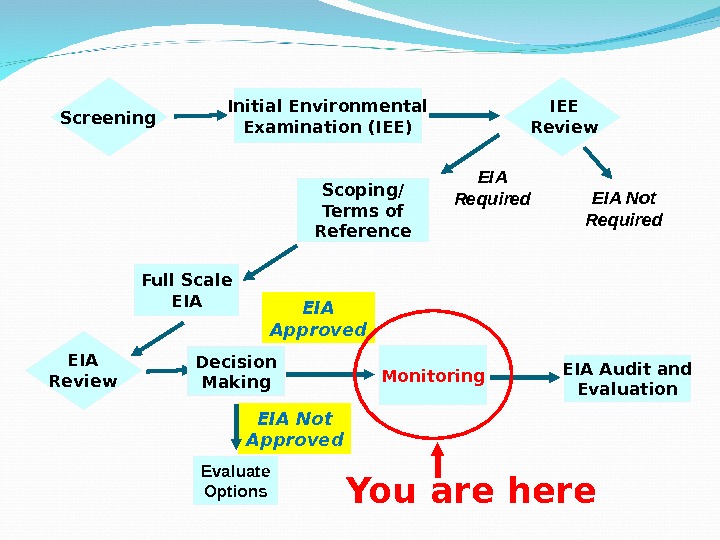
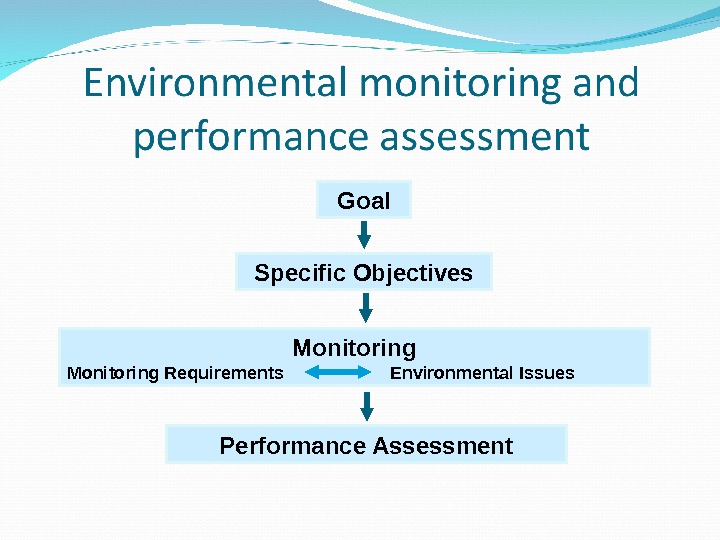
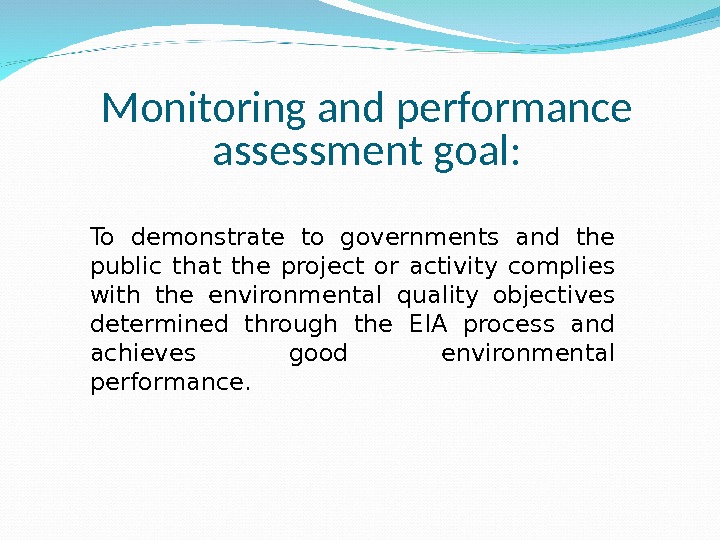
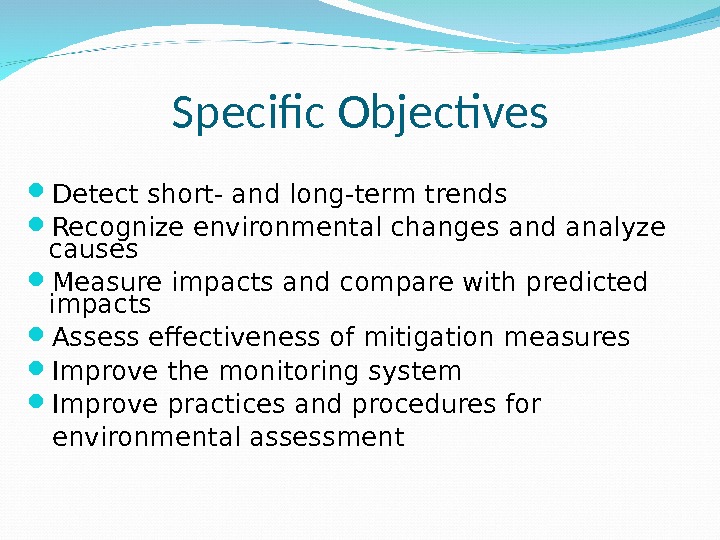
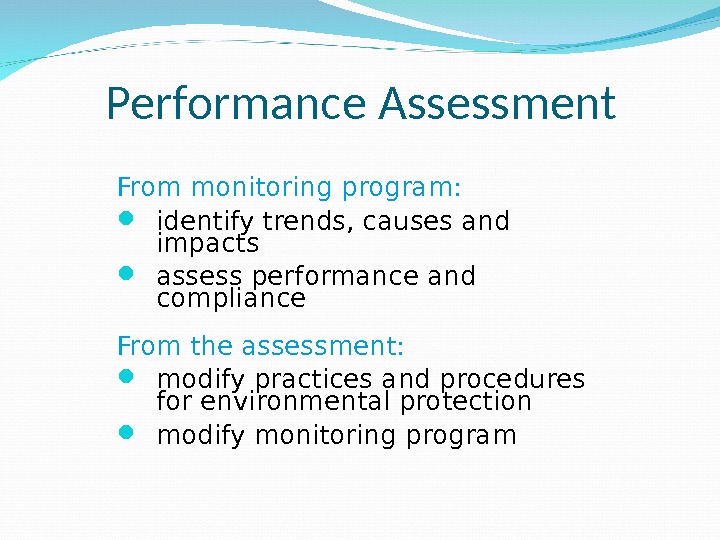

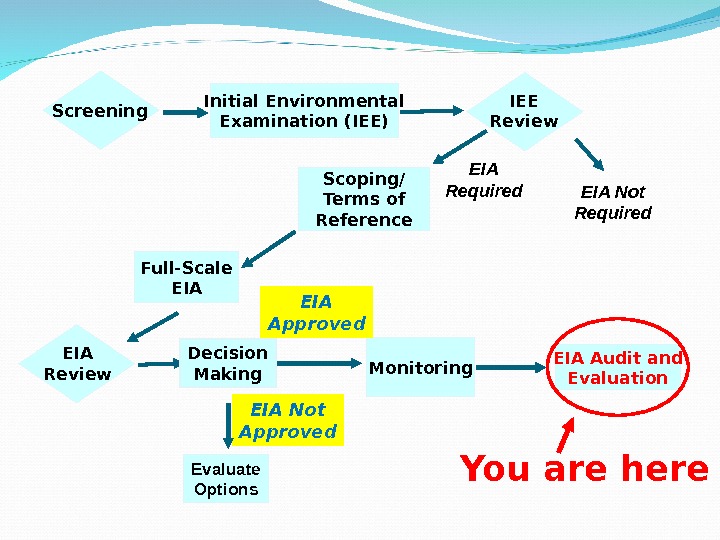
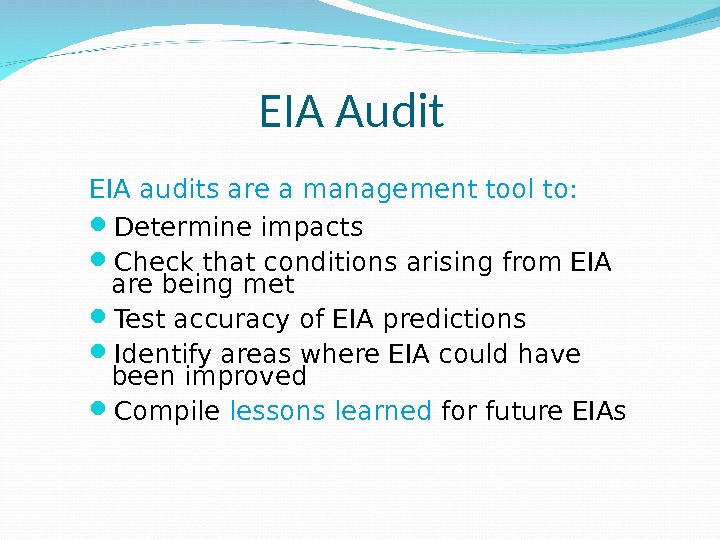

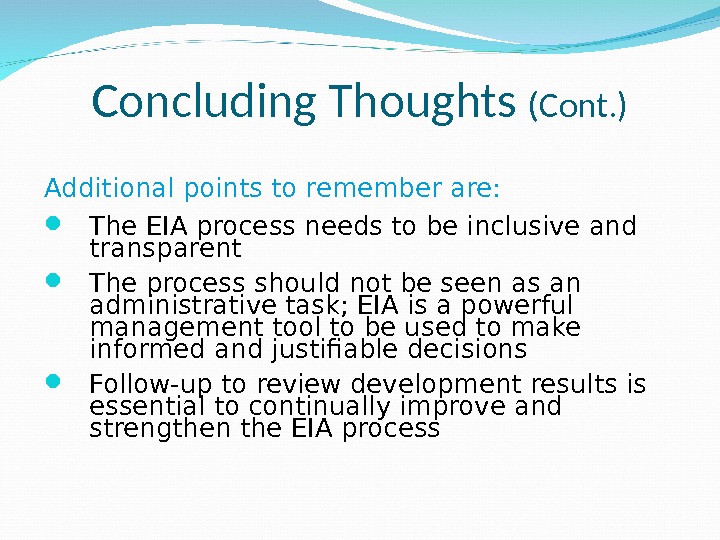
lecture_6_eia_methods.ppt
- Размер: 1.3 Mегабайта
- Количество слайдов: 105
Описание презентации EIA: methods Methods for identifying environmental impacts по слайдам

 EIA: methods Methods for identifying environmental impacts and their significance Common shortcomings concerning the application of EIA in practice
EIA: methods Methods for identifying environmental impacts and their significance Common shortcomings concerning the application of EIA in practice
 EIAEIA is a systematic process to identify , predict and evaluate the environmental effects of proposed actions and projects. A broad definition of environment is adopted. Whenever appropriate social, cultural and health effects are also considered as an integral part of EIA. Finally, particular attention is given in EIA for preventing, mitigating and offsetting the significant adverse effects of proposed undertakings
EIAEIA is a systematic process to identify , predict and evaluate the environmental effects of proposed actions and projects. A broad definition of environment is adopted. Whenever appropriate social, cultural and health effects are also considered as an integral part of EIA. Finally, particular attention is given in EIA for preventing, mitigating and offsetting the significant adverse effects of proposed undertakings
 The Environmental Impact Assessment Process Major steps in the EIA process are: Screening Initial Environmental Examination (IEE) Scoping Full-Scale Assessment EIA Review and Decision Making Monitoring and Follow-Up
The Environmental Impact Assessment Process Major steps in the EIA process are: Screening Initial Environmental Examination (IEE) Scoping Full-Scale Assessment EIA Review and Decision Making Monitoring and Follow-Up
 Screening Initial Environmental Examination (IEE) EIA Not Required. EIA Required Monitoring EIA Audit and Evaluation. IEE Review Scoping/ Terms of Reference Full-Scale EIA Evaluate Options EIA Not Approved. EIA Review Decision Making EIA Approved. You are here
Screening Initial Environmental Examination (IEE) EIA Not Required. EIA Required Monitoring EIA Audit and Evaluation. IEE Review Scoping/ Terms of Reference Full-Scale EIA Evaluate Options EIA Not Approved. EIA Review Decision Making EIA Approved. You are here
 Screening It would be time consuming and a waste of resources for all proposed projects and activities to undergo EIA Not all development projects require an EIA, as some projects may not pose an environmental threat Screening is the process used to determine whether a proposed project or activity requires an EIA and, if so, what level of environmental review is necessary
Screening It would be time consuming and a waste of resources for all proposed projects and activities to undergo EIA Not all development projects require an EIA, as some projects may not pose an environmental threat Screening is the process used to determine whether a proposed project or activity requires an EIA and, if so, what level of environmental review is necessary
 Purpose Identify those projects or activities that may cause potential significant impacts Identify special conditions/analyses that may be required by international funding bodies Categorize the project as one where: Full-Scale EIA required Some further environmental analysis required No further environmental analysis required
Purpose Identify those projects or activities that may cause potential significant impacts Identify special conditions/analyses that may be required by international funding bodies Categorize the project as one where: Full-Scale EIA required Some further environmental analysis required No further environmental analysis required
 Typical Proposals Requiring Full-Scale EIA Infrastructure projects Large-scale industrial activities Resource extractive industries and activities Waste management and disposal Substantial changes in farming or fishing practices
Typical Proposals Requiring Full-Scale EIA Infrastructure projects Large-scale industrial activities Resource extractive industries and activities Waste management and disposal Substantial changes in farming or fishing practices
 Screening Techniques Assessor or decision-maker discretion Project lists with thresholds and triggers Exclusion project lists Preliminary or initial EIAs Combination of these techniques
Screening Techniques Assessor or decision-maker discretion Project lists with thresholds and triggers Exclusion project lists Preliminary or initial EIAs Combination of these techniques
 Screening Criteria Screening criteria typically consider: Project type, location, size (e. g. , capital investment, number of people affected, project capacity, areal extent) Receiving environment characteristics Strength of community opinion Confidence in prediction of impacts
Screening Criteria Screening criteria typically consider: Project type, location, size (e. g. , capital investment, number of people affected, project capacity, areal extent) Receiving environment characteristics Strength of community opinion Confidence in prediction of impacts
 Project Location Requirements for screening: The screening checklist should include a section on site location characteristics, including, at a minimum, the four categories of environmentally critical areas: National Parks Indigenous people’s area Tourist area Ecologically sensitive area
Project Location Requirements for screening: The screening checklist should include a section on site location characteristics, including, at a minimum, the four categories of environmentally critical areas: National Parks Indigenous people’s area Tourist area Ecologically sensitive area
 Project Location (Cont’d) Site selection defines the location of the study area and the specific environmental resource base to be examined Often the single most important factor contributing to a project’s potential negative impacts Regional development plans should be used as guides to select project locations where environmental conditions will be minimally impacted
Project Location (Cont’d) Site selection defines the location of the study area and the specific environmental resource base to be examined Often the single most important factor contributing to a project’s potential negative impacts Regional development plans should be used as guides to select project locations where environmental conditions will be minimally impacted
 Type of Project 1. Infrastructure • Commercial Airport • Mass Transit System • Hotel or Resort Threshold Scale All > 80 Rooms Location — — 4 Critical Areas 2. Agriculture & Natural Resources • Dam or Reservoir • Irrigation > 100 million cu. m. > 15 sq. km. Example Project Screening Criteria
Type of Project 1. Infrastructure • Commercial Airport • Mass Transit System • Hotel or Resort Threshold Scale All > 80 Rooms Location — — 4 Critical Areas 2. Agriculture & Natural Resources • Dam or Reservoir • Irrigation > 100 million cu. m. > 15 sq. km. Example Project Screening Criteria
 Example Project Screening Criteria (Cont. ) Type of Project Threshold Scale Location 3. Industrial and Power • Petrochemical Industry • Oil Refinery • Chlor-Alkaline Industry • Natural Gas Separation • Iron/Steel • Cement Industry • Smelting • Pulp Industry • Industrial Estates • Thermal Power Plants • Mining > 100 tons/day (raw material) All 100 tons/day (output) 100 tons/day, batch All > 50 tons/day All > 10 megawatts All
Example Project Screening Criteria (Cont. ) Type of Project Threshold Scale Location 3. Industrial and Power • Petrochemical Industry • Oil Refinery • Chlor-Alkaline Industry • Natural Gas Separation • Iron/Steel • Cement Industry • Smelting • Pulp Industry • Industrial Estates • Thermal Power Plants • Mining > 100 tons/day (raw material) All 100 tons/day (output) 100 tons/day, batch All > 50 tons/day All > 10 megawatts All
 Asian Development Bank (ADB) Screening Categories All Projects Category A Projects that typically require an EIA study Category C Projects that typically do not require an IEECategory B Projects that typically require only an IEE Examples: • Forestry Research & Extension • Rural Health Services • Marine Sciences Education. Examples: • Forest Industries • Water Impoundment • Industries Examples: • Renewable Energy • Aquaculture • Tourism Development • Infrastructure Rehabilitation
Asian Development Bank (ADB) Screening Categories All Projects Category A Projects that typically require an EIA study Category C Projects that typically do not require an IEECategory B Projects that typically require only an IEE Examples: • Forestry Research & Extension • Rural Health Services • Marine Sciences Education. Examples: • Forest Industries • Water Impoundment • Industries Examples: • Renewable Energy • Aquaculture • Tourism Development • Infrastructure Rehabilitation
 World Bank Screening Categories Category A: An EIA is typically required Category B: An IEE is usually sufficient Category C: Typically no environmental review is required Category D: Environmental Projects Environmental review required, but may be incorporated in feasibility study. ALL PROJECTS
World Bank Screening Categories Category A: An EIA is typically required Category B: An IEE is usually sufficient Category C: Typically no environmental review is required Category D: Environmental Projects Environmental review required, but may be incorporated in feasibility study. ALL PROJECTS
 Prepare the work plan for the initial environmental examination (IEE)Project type on project screening checklist? Get specific IAA requirements. Project scale above the screening threshold? Project located in a critical area? IAA funding, or any other special circumstances? NO NO NO YES No initial environmental examination required (IEE)YESProject Screening Flow Chart Will the project be funded by an IAA? YES YE S NO
Prepare the work plan for the initial environmental examination (IEE)Project type on project screening checklist? Get specific IAA requirements. Project scale above the screening threshold? Project located in a critical area? IAA funding, or any other special circumstances? NO NO NO YES No initial environmental examination required (IEE)YESProject Screening Flow Chart Will the project be funded by an IAA? YES YE S NO
 Screening Initial Environmental Examination (IEE) EIA Not Required. EIA Required Monitoring EIA Audit and Evaluation. IEE Review Scoping/ Terms of Reference Full-Scale EIA Evaluate Options EIA Not Approved. EIA Review Decision Making EIA Approved. You are here
Screening Initial Environmental Examination (IEE) EIA Not Required. EIA Required Monitoring EIA Audit and Evaluation. IEE Review Scoping/ Terms of Reference Full-Scale EIA Evaluate Options EIA Not Approved. EIA Review Decision Making EIA Approved. You are here
 Initial environmental examination (IEE) is intended as a low-cost environmental evaluation that makes use of information already available. Initial Environmental Examination
Initial environmental examination (IEE) is intended as a low-cost environmental evaluation that makes use of information already available. Initial Environmental Examination
 Purpose of IEE Describes the proposed project or activity and examines alternatives Identifies and addresses community concerns to extent possible Identifies and assesses potential environmental effects Directs future action
Purpose of IEE Describes the proposed project or activity and examines alternatives Identifies and addresses community concerns to extent possible Identifies and assesses potential environmental effects Directs future action
 Objectives of IEE Identify all potential environmental concerns relating to a proposed project or activity Identify all significant environmental issues (SEIs) Resolve simple SEIs Develop the focus for follow-up studies based on unresolved SEIs
Objectives of IEE Identify all potential environmental concerns relating to a proposed project or activity Identify all significant environmental issues (SEIs) Resolve simple SEIs Develop the focus for follow-up studies based on unresolved SEIs
 Possible IEE Outcomes 1. No requirement for further environmental study; proposal not anticipated to have significant impact 2. Limited environmental study needed; environmental impacts are known and can be easily mitigated 3. Full-scale EIA required; impacts unknown or likely to be significant
Possible IEE Outcomes 1. No requirement for further environmental study; proposal not anticipated to have significant impact 2. Limited environmental study needed; environmental impacts are known and can be easily mitigated 3. Full-scale EIA required; impacts unknown or likely to be significant
 Project Screening Identifies projects that typically contain potential significant issues Initial Environmental Examination 1. Identifies potential significant environmental issues associated with a project 2. Grades effects and identifies actual Significant Environmental Issues (SEIs) 3. Resolves simple SEIs 4. Recommends further action for resolving outstanding SEIs Full-Scale EIA or Other Additional Study Resolves any remaining significant environmental issues
Project Screening Identifies projects that typically contain potential significant issues Initial Environmental Examination 1. Identifies potential significant environmental issues associated with a project 2. Grades effects and identifies actual Significant Environmental Issues (SEIs) 3. Resolves simple SEIs 4. Recommends further action for resolving outstanding SEIs Full-Scale EIA or Other Additional Study Resolves any remaining significant environmental issues
 1. Identify Potential Significant Environmental Issues 2. Obtain Information 3. Effects Classification/ Identification of Significant Environmental Issues (SEIs)4. Resolve SEIs Where Possible (Review Alternatives/Develop Environmental Management Plans and Protection Measures) The IEE makes recommendation s for further study: Full-Scale EIAIEE is the final EIA Report, including: 1. SEIs 2. EPM 3. EMP 5. Are all SEIs resolved? YES NO
1. Identify Potential Significant Environmental Issues 2. Obtain Information 3. Effects Classification/ Identification of Significant Environmental Issues (SEIs)4. Resolve SEIs Where Possible (Review Alternatives/Develop Environmental Management Plans and Protection Measures) The IEE makes recommendation s for further study: Full-Scale EIAIEE is the final EIA Report, including: 1. SEIs 2. EPM 3. EMP 5. Are all SEIs resolved? YES NO
 Identification of Potential Significant Issues 1. Identify valued environmental/ecosystem components (VECs) Professional judgement/past experience Legislative requirements Stakeholder and community values 2. Identify the potential for impacts to each VEC 3. Identify potential for cumulative impacts (i. e. to the site as a whole and to the region)
Identification of Potential Significant Issues 1. Identify valued environmental/ecosystem components (VECs) Professional judgement/past experience Legislative requirements Stakeholder and community values 2. Identify the potential for impacts to each VEC 3. Identify potential for cumulative impacts (i. e. to the site as a whole and to the region)
 Natural physical resources (e. g. , surface and groundwater, air, climate, soil) Natural biological resources (e. g. , forests, wetlands, river and lake ecology) Economic development resources (e. g. , agriculture, industry, infrastructure, tourism) Quality of life (e. g. , public health, socio-economic, cultural, aesthetics) National commitments (e. g. , endangered species protection)Commonly Considered VECs
Natural physical resources (e. g. , surface and groundwater, air, climate, soil) Natural biological resources (e. g. , forests, wetlands, river and lake ecology) Economic development resources (e. g. , agriculture, industry, infrastructure, tourism) Quality of life (e. g. , public health, socio-economic, cultural, aesthetics) National commitments (e. g. , endangered species protection)Commonly Considered VECs
 Methods for Identifying Potential Impacts to VECs Matrices » Sector-related » Project type Checklists Professional expertise and experience with similar project types Combination of techniques
Methods for Identifying Potential Impacts to VECs Matrices » Sector-related » Project type Checklists Professional expertise and experience with similar project types Combination of techniques
 Example: Sector-related matrix Ports and Harbours Airports Rapid Transit Highways Oil/Gas Pipelines. Development Projects Valued Env. Component (VEC)Surface W ater Q uality A ir Q uality Seism ology/G eology Erosion Land Q uality Fisheries Forests Terrestrial W ildlife N oise Land U se Aesthetics Industries Resettlem ent A rchaeological/H istoric al Public H ealth Socioeconom ic Insignificant Impact. Significant Impact Moderate — Significant Impact
Example: Sector-related matrix Ports and Harbours Airports Rapid Transit Highways Oil/Gas Pipelines. Development Projects Valued Env. Component (VEC)Surface W ater Q uality A ir Q uality Seism ology/G eology Erosion Land Q uality Fisheries Forests Terrestrial W ildlife N oise Land U se Aesthetics Industries Resettlem ent A rchaeological/H istoric al Public H ealth Socioeconom ic Insignificant Impact. Significant Impact Moderate — Significant Impact
 Project Checklist Example Potential Damages: Actions Affecting Resources and Values: 1. Disruption of hydrology 2. Resettlement 3. Encroachment on precious ecology 4. Encroachment on historic/ cultural values 5. Cooling tower obstruction 6. Regional flooding hazard 7. Waste emissions related to siting 1. Impairment of other beneficial water uses 2. Social inequities 3. Loss of these values 4. Loss of these values 5. Conflicts with other beneficial water uses 6. Hazard to plant operations 7. Intensification of problems of pollution control
Project Checklist Example Potential Damages: Actions Affecting Resources and Values: 1. Disruption of hydrology 2. Resettlement 3. Encroachment on precious ecology 4. Encroachment on historic/ cultural values 5. Cooling tower obstruction 6. Regional flooding hazard 7. Waste emissions related to siting 1. Impairment of other beneficial water uses 2. Social inequities 3. Loss of these values 4. Loss of these values 5. Conflicts with other beneficial water uses 6. Hazard to plant operations 7. Intensification of problems of pollution control
 EIA Procedures and Decision Making 30 Considerations in Determining Potential Effects Impacts to: individual VECs entire site (i. e. , impacts to all VECs combined) cumulative impacts to the area (i. e. , considering other existing and planned projects) Impacts from all phases of the project (i. e. , construction, operation, decommissioning) Impacts on different time-scales Impacts from different orders of impact
EIA Procedures and Decision Making 30 Considerations in Determining Potential Effects Impacts to: individual VECs entire site (i. e. , impacts to all VECs combined) cumulative impacts to the area (i. e. , considering other existing and planned projects) Impacts from all phases of the project (i. e. , construction, operation, decommissioning) Impacts on different time-scales Impacts from different orders of impact
 Example: Orders of Impact Loss of Fisheries Income Social Tension and Poverty Intensified Loss of Plain Fisheries Dry Flood Plains. River Embankment First Order Second Order Third Order Fourth Order
Example: Orders of Impact Loss of Fisheries Income Social Tension and Poverty Intensified Loss of Plain Fisheries Dry Flood Plains. River Embankment First Order Second Order Third Order Fourth Order
 Data Requirements Project Type Size Location Area of potential impact Physical resources Biological resources Economic development resources Quality of life Other existing and planned projects
Data Requirements Project Type Size Location Area of potential impact Physical resources Biological resources Economic development resources Quality of life Other existing and planned projects
 Sources of Information Existing reports on environmental resources in the area Previous assessment reports » IEE and EIA reports on similar project types » Reports on other projects in the region that may cause similar disturbances Regional planning, policy and other reports Field studies Local citizens and traditional knowledge
Sources of Information Existing reports on environmental resources in the area Previous assessment reports » IEE and EIA reports on similar project types » Reports on other projects in the region that may cause similar disturbances Regional planning, policy and other reports Field studies Local citizens and traditional knowledge
 EIA Procedures and Decision Making 34 Effects Classification Effects vary in significance, depending on their: Nature: positive, negative, direct, indirect, cumulative, synergistic Magnitude Extent/location: area/volume covered, distribution Timing: during construction, operation, decommissioning, immediate, delayed, rate of change
EIA Procedures and Decision Making 34 Effects Classification Effects vary in significance, depending on their: Nature: positive, negative, direct, indirect, cumulative, synergistic Magnitude Extent/location: area/volume covered, distribution Timing: during construction, operation, decommissioning, immediate, delayed, rate of change
 EIA Procedures and Decision Making 35 Effects Classification (Cont’d) Duration: short-term, long-term, intermittent, continuous Reversibility/irreversibility Likelihood: risk, uncertainty or confidence in the prediction
EIA Procedures and Decision Making 35 Effects Classification (Cont’d) Duration: short-term, long-term, intermittent, continuous Reversibility/irreversibility Likelihood: risk, uncertainty or confidence in the prediction
 EIA Procedures and Decision Making 36 Criteria for Evaluating Potential Effects Importance of affected resource Magnitude and extent of disturbance Duration and frequency Risk/likelihood of occurrence Reversibility Contribution to cumulative impacts
EIA Procedures and Decision Making 36 Criteria for Evaluating Potential Effects Importance of affected resource Magnitude and extent of disturbance Duration and frequency Risk/likelihood of occurrence Reversibility Contribution to cumulative impacts
 EIA Procedures and Decision Making 37 Options for Addressing SEIs 1. Resolve SEIs within IEE Number of different strategies for addressing SEIs Strategies chosen will depend on the number, type, and significance of identified SEIs 2. Identify need for future studies to address SEIs (e. g. , full-scale EIA or other detailed studies)
EIA Procedures and Decision Making 37 Options for Addressing SEIs 1. Resolve SEIs within IEE Number of different strategies for addressing SEIs Strategies chosen will depend on the number, type, and significance of identified SEIs 2. Identify need for future studies to address SEIs (e. g. , full-scale EIA or other detailed studies)
 EIA Procedures and Decision Making 38 Possible Strategies for Resolving SEIs Within the IEE Re-evaluate regional plans (e. g. , to address cumulative impacts with other planned projects) Review project options (i. e. , alternatives and modifications) Evaluate site mitigation strategies; including compensation strategies Likely will use a combination of strategies
EIA Procedures and Decision Making 38 Possible Strategies for Resolving SEIs Within the IEE Re-evaluate regional plans (e. g. , to address cumulative impacts with other planned projects) Review project options (i. e. , alternatives and modifications) Evaluate site mitigation strategies; including compensation strategies Likely will use a combination of strategies
 EIA Procedures and Decision Making 39 Examples of Project Alternatives No-build alternative Demand alternatives (e. g. , using existing energy capacity more efficiency rather than building more capacity) Activity alternatives (e. g. , providing public transport rather than increasing road capacity) Location alternatives
EIA Procedures and Decision Making 39 Examples of Project Alternatives No-build alternative Demand alternatives (e. g. , using existing energy capacity more efficiency rather than building more capacity) Activity alternatives (e. g. , providing public transport rather than increasing road capacity) Location alternatives
 EIA Procedures and Decision Making 40 More Examples of Project Alternatives Process alternatives (e. g. , re-use of process water, reducing waste, different logging methods) Scheduling alternatives (e. g. , timing of project construction) Input alternatives (e. g. , use of different raw materials or sources of energy)
EIA Procedures and Decision Making 40 More Examples of Project Alternatives Process alternatives (e. g. , re-use of process water, reducing waste, different logging methods) Scheduling alternatives (e. g. , timing of project construction) Input alternatives (e. g. , use of different raw materials or sources of energy)
 EIA Procedures and Decision Making 41 Effects Significance Grading No effect Insignificant effect Unknown significant effect Significant effect, resolution is within the scope of the IEE Significant effect, resolution is outside the scope of the IEEIncreasin g Severity
EIA Procedures and Decision Making 41 Effects Significance Grading No effect Insignificant effect Unknown significant effect Significant effect, resolution is within the scope of the IEE Significant effect, resolution is outside the scope of the IEEIncreasin g Severity
 Issues with: No Effect Issues with: Insignificant Effect Issues with: Unknown Significant Effect Issues with: Significant Effects within the Scope of the IEEWhere to from here? Issues with: Significant Effects outside the Scope of the IEE No Further Action Required : Write up findings in brief IEE Write up findings and recommendations in IEE report Action Required : Develop the Environmental Management Plan & Protection Measures to Resolve Issues Action Required: Identify Information Needs and Tasks Required to Resolve Outstanding Issues In Additional Studies
Issues with: No Effect Issues with: Insignificant Effect Issues with: Unknown Significant Effect Issues with: Significant Effects within the Scope of the IEEWhere to from here? Issues with: Significant Effects outside the Scope of the IEE No Further Action Required : Write up findings in brief IEE Write up findings and recommendations in IEE report Action Required : Develop the Environmental Management Plan & Protection Measures to Resolve Issues Action Required: Identify Information Needs and Tasks Required to Resolve Outstanding Issues In Additional Studies
 Example IEE Report Contents 1. Description of the project 2. Description of the environment 3. Screening of potential environmental issues and rationale for their significance grading 4. Environmental protection measures 5. Environmental monitoring and institutional requirements 6. Recommendations for additional studies 7. Conclusions
Example IEE Report Contents 1. Description of the project 2. Description of the environment 3. Screening of potential environmental issues and rationale for their significance grading 4. Environmental protection measures 5. Environmental monitoring and institutional requirements 6. Recommendations for additional studies 7. Conclusions
 Screening Initial Environmental Examination (IEE) EIA Not Required. EIA Required Monitoring EIA Audit and Evaluation. IEE Review Scoping/ Terms of Reference Full-Scale EIA Evaluate Options EIA Not Approved. EIA Review Decision Making EIA Approved You are here
Screening Initial Environmental Examination (IEE) EIA Not Required. EIA Required Monitoring EIA Audit and Evaluation. IEE Review Scoping/ Terms of Reference Full-Scale EIA Evaluate Options EIA Not Approved. EIA Review Decision Making EIA Approved You are here
 Terms of Reference Context IEE Project Proceeds according to terms of IEE Terms of Reference 1. Background 2. Impact Issues Significant Issues Relevant Resources Report Formatting 3. Work Plan When/Who/How of Task Completion Full-Scal e EIAYes No. IEE Review: All potential SEIs resolved
Terms of Reference Context IEE Project Proceeds according to terms of IEE Terms of Reference 1. Background 2. Impact Issues Significant Issues Relevant Resources Report Formatting 3. Work Plan When/Who/How of Task Completion Full-Scal e EIAYes No. IEE Review: All potential SEIs resolved
 Scoping A process of interaction between government agencies and project proponents Identifies: spatial and temporal boundaries for the EIA important issues and concern information necessary for decision making significant effects and factors to be considered Establishes Terms of Reference for full-scale EI
Scoping A process of interaction between government agencies and project proponents Identifies: spatial and temporal boundaries for the EIA important issues and concern information necessary for decision making significant effects and factors to be considered Establishes Terms of Reference for full-scale EI
 Importance of Scoping Serves to facilitate efficient EIA by identifying appropriate areas for consideration (e. g, key issues, concerns, alternatives) Reduces likelihood of deficiencies in EIA (e. g. , ensures that important issues are not overlooked) Prevents unnecessary expenditures and time delays from oversights or unnecessary areas of study
Importance of Scoping Serves to facilitate efficient EIA by identifying appropriate areas for consideration (e. g, key issues, concerns, alternatives) Reduces likelihood of deficiencies in EIA (e. g. , ensures that important issues are not overlooked) Prevents unnecessary expenditures and time delays from oversights or unnecessary areas of study
 Terms of Reference Content Background information section should include: Project Description (i. e. , type, magnitude, location, alternatives and constraints) Environmental Setting (i. e. , delineation of study area, listing of environmental resources and sensitive or special value areas) Background Reports (e. g. , aspects of the environmental setting, previous projects with relevant impacts or resources)
Terms of Reference Content Background information section should include: Project Description (i. e. , type, magnitude, location, alternatives and constraints) Environmental Setting (i. e. , delineation of study area, listing of environmental resources and sensitive or special value areas) Background Reports (e. g. , aspects of the environmental setting, previous projects with relevant impacts or resources)
 Terms of Reference Content (Cont. ) Specific EIA requirements typically include: EIA objectives Institutional context (i. e. , legal and policy requirements) Significant issues of concern (SEIs) Required information and data, methodologies for impact assessment Process for incorporating public input
Terms of Reference Content (Cont. ) Specific EIA requirements typically include: EIA objectives Institutional context (i. e. , legal and policy requirements) Significant issues of concern (SEIs) Required information and data, methodologies for impact assessment Process for incorporating public input
 Work Plan Example Month 1 Month 2 Month 3 Month 4 Month 5 Detailed Task Assignment 1. Waterlogging and Soil Salinity 2. Field Data: Collate, Fill Gaps, Organize 3. Models: Review, Verify, Reconcile 4. Drainage: Develop Final Criteria, Perform Design 5. Compile Report 6. Land Acquisition and Resettlement 7. Project Proponent Document: Review and Verify 8. Environmental Impact 9. Social Impact and Equity 10. Public Participation 11. Monitoring and Evaluation
Work Plan Example Month 1 Month 2 Month 3 Month 4 Month 5 Detailed Task Assignment 1. Waterlogging and Soil Salinity 2. Field Data: Collate, Fill Gaps, Organize 3. Models: Review, Verify, Reconcile 4. Drainage: Develop Final Criteria, Perform Design 5. Compile Report 6. Land Acquisition and Resettlement 7. Project Proponent Document: Review and Verify 8. Environmental Impact 9. Social Impact and Equity 10. Public Participation 11. Monitoring and Evaluation
 Screening Initial Environmental Examination (IEE) EIA Not Required. EIA Required Monitoring EIA Audit and Evaluation. IEE Review Scoping/ Terms of Reference Full-Scale EIA Evaluate Options EIA Not Approved. EIA Review Decision Making EIA Approved. You are here
Screening Initial Environmental Examination (IEE) EIA Not Required. EIA Required Monitoring EIA Audit and Evaluation. IEE Review Scoping/ Terms of Reference Full-Scale EIA Evaluate Options EIA Not Approved. EIA Review Decision Making EIA Approved. You are here
 EIA in the Project Cycle Reconnaissance Survey Pre-feasibility Study Final Design Construction Operation. Conventional Project Planning Monitoring Operations and Environmental Effects. Corresponding Environmental Protection Activity Initial Environmental Examination Environmental Impact Assessment Checking Design Monitoring Construction. Project Screening
EIA in the Project Cycle Reconnaissance Survey Pre-feasibility Study Final Design Construction Operation. Conventional Project Planning Monitoring Operations and Environmental Effects. Corresponding Environmental Protection Activity Initial Environmental Examination Environmental Impact Assessment Checking Design Monitoring Construction. Project Screening
 Evaluate the IEE’s Treatment of Significant Issues Identify Information Gaps Review Impact Pathways Conduct Field Research Conduct Public Participation Perform Impact Prediction Perform Risk Assessment Evaluate Economic Impacts Review Applicable Standards Design Environmental Protection Measures Prepare Environmental Management Plan Design Monitoring Program
Evaluate the IEE’s Treatment of Significant Issues Identify Information Gaps Review Impact Pathways Conduct Field Research Conduct Public Participation Perform Impact Prediction Perform Risk Assessment Evaluate Economic Impacts Review Applicable Standards Design Environmental Protection Measures Prepare Environmental Management Plan Design Monitoring Program
 Full-Scale EIA Overview Input = Outstanding SEIs from IEE Assessment phase: Qualitative/quantitative analysis of SEI impact significance Mitigation development phase: Select appropriate mitigation measures Residual impact significance
Full-Scale EIA Overview Input = Outstanding SEIs from IEE Assessment phase: Qualitative/quantitative analysis of SEI impact significance Mitigation development phase: Select appropriate mitigation measures Residual impact significance
 EIA Impact Identification Methods C h e c k lis t s M a t r ic e s N e t w o r k s O v e r la y s /G IS E x p e r t S y s t e m s R is k A s s e s s m e n t Qualitative Quantitative
EIA Impact Identification Methods C h e c k lis t s M a t r ic e s N e t w o r k s O v e r la y s /G IS E x p e r t S y s t e m s R is k A s s e s s m e n t Qualitative Quantitative
 Selection of Appropriate Methods Type and size of proposal Type of alternatives being assessed Nature of likely impacts Experience using EIA methods Resources available Nature of public involvement Procedural/administrative requirements
Selection of Appropriate Methods Type and size of proposal Type of alternatives being assessed Nature of likely impacts Experience using EIA methods Resources available Nature of public involvement Procedural/administrative requirements
 Checklists ADVANTAGES Simple to understand use Good for site selection and priority setting DISADVANTAGES Do not distinguish between direct and indirect impacts Do not link action and impact Qualitative
Checklists ADVANTAGES Simple to understand use Good for site selection and priority setting DISADVANTAGES Do not distinguish between direct and indirect impacts Do not link action and impact Qualitative
 Matrices ADVANTAGES Link action to impact Good method for displaying EIA results DISADVANTAGES Difficult to distinguish direct and indirect impacts Significant potential for double-counting of impacts Qualitative
Matrices ADVANTAGES Link action to impact Good method for displaying EIA results DISADVANTAGES Difficult to distinguish direct and indirect impacts Significant potential for double-counting of impacts Qualitative
 Networks ADVANTAGES Link action to impact Useful in simplified form in checking for second order impacts Handles direct and indirect impacts DISADVANTAGES Can become overly complex if used beyond simplified version Qualitative
Networks ADVANTAGES Link action to impact Useful in simplified form in checking for second order impacts Handles direct and indirect impacts DISADVANTAGES Can become overly complex if used beyond simplified version Qualitative
 Overlays ADVANTAGES Easy to understand use Good display method Good for site selection setting DISADVANTAGES Address only direct impacts Do not address impact duration or probability
Overlays ADVANTAGES Easy to understand use Good display method Good for site selection setting DISADVANTAGES Address only direct impacts Do not address impact duration or probability
 Expert Systems ADVANTAGES Excellent for impact identification and analysis Good for experimenting Semi-quantitativ e to quantitative DISADVANTAGES Heavy reliance on knowledge and data Often complex and expensive
Expert Systems ADVANTAGES Excellent for impact identification and analysis Good for experimenting Semi-quantitativ e to quantitative DISADVANTAGES Heavy reliance on knowledge and data Often complex and expensive
 Impact Characteristics (e. g. , spatial extent) Impact Importance (e. g. , value)x = Impact Significance
Impact Characteristics (e. g. , spatial extent) Impact Importance (e. g. , value)x = Impact Significance
 Characteristics Affecting Impact Significance Nature of impact (e. g. , positive, negative, synergistic) Extent and magnitude Timing (i. e. , construction, operation, closure) Duration (i. e. , short, chronic, intermittent) Reversibility/irreversibility Likelihood (i. e. , probability, uncertainty)
Characteristics Affecting Impact Significance Nature of impact (e. g. , positive, negative, synergistic) Extent and magnitude Timing (i. e. , construction, operation, closure) Duration (i. e. , short, chronic, intermittent) Reversibility/irreversibility Likelihood (i. e. , probability, uncertainty)
 Some Criteria for Significance Importance: the value that is attached to the affected environmental component Extent of disturbance: the area expected to be impacted Duration and frequency of disturbance Reversibility Risk: probability of an unplanned incident caused by the project
Some Criteria for Significance Importance: the value that is attached to the affected environmental component Extent of disturbance: the area expected to be impacted Duration and frequency of disturbance Reversibility Risk: probability of an unplanned incident caused by the project
 Assessing Significance Considerable expert judgement and technical knowledge are often required to fully understand the nature and extent of environmental impacts Categories of significance include: no impact significant impact unknown impact mitigated impact
Assessing Significance Considerable expert judgement and technical knowledge are often required to fully understand the nature and extent of environmental impacts Categories of significance include: no impact significant impact unknown impact mitigated impact
 Guidelines for Assessing Significance Use rational and objective methods Provide consistency for comparison of project alternatives Document values and beliefs used in making judgment decisions Apply impact significance criteria, e. g. , Ecological importance/sustainability criteria Social importance Environmental standards
Guidelines for Assessing Significance Use rational and objective methods Provide consistency for comparison of project alternatives Document values and beliefs used in making judgment decisions Apply impact significance criteria, e. g. , Ecological importance/sustainability criteria Social importance Environmental standards
 Ecological Importance Effect on plant and animal habitat Rare and endangered species Ecosystem resilience, sensitivity, biodiversity and carrying capacity Population viability Community viability
Ecological Importance Effect on plant and animal habitat Rare and endangered species Ecosystem resilience, sensitivity, biodiversity and carrying capacity Population viability Community viability
 Social Importance Effects on human health and safety Potential loss of managed resources (e. g. , fish, farmland, water) Recreation or aesthetic value Demands on public resources Demands on transportation or other infrastructure Demographic effects
Social Importance Effects on human health and safety Potential loss of managed resources (e. g. , fish, farmland, water) Recreation or aesthetic value Demands on public resources Demands on transportation or other infrastructure Demographic effects
 Environmental Standards Permit-based limits on effluent discharge concentrations Clean air standards, water quality standards Plans or policies that protect or limit use of natural resources
Environmental Standards Permit-based limits on effluent discharge concentrations Clean air standards, water quality standards Plans or policies that protect or limit use of natural resources
 Evaluate Environmental Impacts Design Environmental Protection Measures Review Applicable Standards
Evaluate Environmental Impacts Design Environmental Protection Measures Review Applicable Standards
 Develop Alternative Environmental Protection Measures Evaluate Implementation Costs Assess Environmental Effectiveness Select Final Environmental Protection Measures
Develop Alternative Environmental Protection Measures Evaluate Implementation Costs Assess Environmental Effectiveness Select Final Environmental Protection Measures
 Understand the Problem What is the problem? When will the problem occur? When should the problem be addressed? Where should the problem be addressed? How should the problem be addressed? Who stands to lose or gain? Good understanding of problems is critical to development of effective mitigation measures
Understand the Problem What is the problem? When will the problem occur? When should the problem be addressed? Where should the problem be addressed? How should the problem be addressed? Who stands to lose or gain? Good understanding of problems is critical to development of effective mitigation measures
 Mitigation Options Alternative ways of meeting society’s need for the project Changes in project planning and design Improving monitoring and management Monetary compensation Replacing, relocating, rehabilitating
Mitigation Options Alternative ways of meeting society’s need for the project Changes in project planning and design Improving monitoring and management Monetary compensation Replacing, relocating, rehabilitating
 Environmental Management Plan Mitigation measures chosen are documented as part of the EMP which specifies how they are to be carried out: State policy and standards Designate responsibility Provide schedule for tasks Allocate responsibility for tasks Include system for progress reporting Include system for monitoring/auditing Develop a contingency plan
Environmental Management Plan Mitigation measures chosen are documented as part of the EMP which specifies how they are to be carried out: State policy and standards Designate responsibility Provide schedule for tasks Allocate responsibility for tasks Include system for progress reporting Include system for monitoring/auditing Develop a contingency plan
 EIA Reporting Variations in titles but all the same content: Environmental Impact Assessment report (EIA report) Environmental Impact Statement (EIS) Environmental Assessment report (EA report) Environmental Effects Statement (EES) Local usage; often shortened to just EI
EIA Reporting Variations in titles but all the same content: Environmental Impact Assessment report (EIA report) Environmental Impact Statement (EIS) Environmental Assessment report (EA report) Environmental Effects Statement (EES) Local usage; often shortened to just EI
 Effective Reporting Assists the project proponent to plan (e. g. , changes to the project design or scheduling recommended as mitigation measures) Assists decision makers in deciding whether to approve or reject proposal, and if approved with what conditions Helps the public to understand core issues of concern
Effective Reporting Assists the project proponent to plan (e. g. , changes to the project design or scheduling recommended as mitigation measures) Assists decision makers in deciding whether to approve or reject proposal, and if approved with what conditions Helps the public to understand core issues of concern
 EIA Report Contents Executive summary Objectives of the proposal Description of proposal and alternatives Relationship to current land use policies Description of expected conditions Evaluation of impacts for each alternative Mitigation and monitoring plans Appendices
EIA Report Contents Executive summary Objectives of the proposal Description of proposal and alternatives Relationship to current land use policies Description of expected conditions Evaluation of impacts for each alternative Mitigation and monitoring plans Appendices
 Executive Summary Definition: A well written stand-alone document which contains the information necessary for the reader to understand the critical environmental issues and how the issues are to be addressed and resolved Audience: targeted at decision makers and international funding bodies Special Requirements: international funding bodies often require executive summaries to be submitted in English
Executive Summary Definition: A well written stand-alone document which contains the information necessary for the reader to understand the critical environmental issues and how the issues are to be addressed and resolved Audience: targeted at decision makers and international funding bodies Special Requirements: international funding bodies often require executive summaries to be submitted in English
 Executive Summary (Cont. ) What the executive summary MUST contain: a summary of impacts for each SEI background information including base maps offsetting, enhancement, and mitigation measures for minimizing negative impacts recommendations and conclusions summary of the environmental management plan
Executive Summary (Cont. ) What the executive summary MUST contain: a summary of impacts for each SEI background information including base maps offsetting, enhancement, and mitigation measures for minimizing negative impacts recommendations and conclusions summary of the environmental management plan
 Project Information Status of project Planning, design and implementation strategies Requirements for materials, water, energy, equipment Planned processes and products Visual aids (e. g. , maps) Options (e. g. , siting, layout) Summary of technical, economic and environmental features
Project Information Status of project Planning, design and implementation strategies Requirements for materials, water, energy, equipment Planned processes and products Visual aids (e. g. , maps) Options (e. g. , siting, layout) Summary of technical, economic and environmental features
 Evaluating Impacts for Each Alternative Assessment of impacts Data and predictive methods used Uncertainty and gaps in knowledge Compliance with standards Criteria used to assess significance Proposed impact avoidance or mitigation measures
Evaluating Impacts for Each Alternative Assessment of impacts Data and predictive methods used Uncertainty and gaps in knowledge Compliance with standards Criteria used to assess significance Proposed impact avoidance or mitigation measures
 Environmental management and monitoring plans Describe proposed mitigation measures Contain schedule for implementation Assign responsibility for implementation Detail a monitoring program Detail proposed reporting and review procedures
Environmental management and monitoring plans Describe proposed mitigation measures Contain schedule for implementation Assign responsibility for implementation Detail a monitoring program Detail proposed reporting and review procedures
 Appendices Technical information Glossary and Acronyms Public involvement summary Information sources/references Details of study team Terms of Reference
Appendices Technical information Glossary and Acronyms Public involvement summary Information sources/references Details of study team Terms of Reference
 Common reporting shortcomings Object of activity described too narrowly Incomplete description of activity Alternatives do not account for the environment Key problems not described Sensitive environment aspects overlooked Standards and legislation are not described or alternatives do not comply with them Some mitigating measures not considered
Common reporting shortcomings Object of activity described too narrowly Incomplete description of activity Alternatives do not account for the environment Key problems not described Sensitive environment aspects overlooked Standards and legislation are not described or alternatives do not comply with them Some mitigating measures not considered
 Common Reporting Shortcomings (Cont. ) Best alternative not described or described insufficiently Serious impacts are not mentioned or not correctly described Outdated or ineffective prediction models used Impacts are not compared with standards or targets Incorrect conclusions drawn
Common Reporting Shortcomings (Cont. ) Best alternative not described or described insufficiently Serious impacts are not mentioned or not correctly described Outdated or ineffective prediction models used Impacts are not compared with standards or targets Incorrect conclusions drawn
 Screening Initial Environmental Examination (IEE) EIA Not Required. EIA Required Monitoring EIA Audit and Evaluation. IEE Review Scoping/ Terms of Reference Full-Scale EIA Evaluate Options EIA Not Approved. EIA Review Decision Making EIA Approved. You are here
Screening Initial Environmental Examination (IEE) EIA Not Required. EIA Required Monitoring EIA Audit and Evaluation. IEE Review Scoping/ Terms of Reference Full-Scale EIA Evaluate Options EIA Not Approved. EIA Review Decision Making EIA Approved. You are here
 EIA Review Determines whether the EIA report is an adequate assessment of environmental concerns and is of sufficient relevance and quality for decision making.
EIA Review Determines whether the EIA report is an adequate assessment of environmental concerns and is of sufficient relevance and quality for decision making.
 EIA Review Objectives Determine whether EIA report provides an adequate assessment Collects range of stakeholder opinion regarding the acceptability of the EIA report and of the proposed project or activity based on the EIA findings Ensures EIA compliance with established procedures (e. g. , Terms of Reference, existing plans and policies)
EIA Review Objectives Determine whether EIA report provides an adequate assessment Collects range of stakeholder opinion regarding the acceptability of the EIA report and of the proposed project or activity based on the EIA findings Ensures EIA compliance with established procedures (e. g. , Terms of Reference, existing plans and policies)
 Critical Areas of Review Compliance with the Terms of Reference Examination of alternatives, environmental setting, impact analysis, mitigation, and impact management and monitoring Sufficiency and accuracy of information Use of scientifically-defensible analytical techniques Conduct of the EIA; completeness and comprehensiveness of the assessment process Sufficiency of information provided for decision- making purposes
Critical Areas of Review Compliance with the Terms of Reference Examination of alternatives, environmental setting, impact analysis, mitigation, and impact management and monitoring Sufficiency and accuracy of information Use of scientifically-defensible analytical techniques Conduct of the EIA; completeness and comprehensiveness of the assessment process Sufficiency of information provided for decision- making purposes
 Review Methods General statistics Project specific checklists Ad hoc processes Expert opinion by accredited reviewers Public review Panels of inquiry, independent commissions Legal approaches
Review Methods General statistics Project specific checklists Ad hoc processes Expert opinion by accredited reviewers Public review Panels of inquiry, independent commissions Legal approaches
 Review Step-by-Step Set the intensity of the review (e. g. , scale and depth) Select review methods and identify review criteria; make sure to include public input Select reviewers Conduct the review Determine remedial options Publish review report
Review Step-by-Step Set the intensity of the review (e. g. , scale and depth) Select review methods and identify review criteria; make sure to include public input Select reviewers Conduct the review Determine remedial options Publish review report
 Decision Making EIA is an ongoing process of review, negotiation and incremental decision making Ultimately, an administrative or political decision is made whether to proceed or not to proceed with a proposed project or activity Function of the EIA report is to provide objective assessment of issues to inform and facilitate the decision-making process
Decision Making EIA is an ongoing process of review, negotiation and incremental decision making Ultimately, an administrative or political decision is made whether to proceed or not to proceed with a proposed project or activity Function of the EIA report is to provide objective assessment of issues to inform and facilitate the decision-making process
 Requirements for Decision Makers Decision makers need an understanding of: Principles and practices of sustainable development EIA aims, concepts and processes EIA guidelines, policy, law and conventions EIA implementation within the decision-making agency or organization Public involvement processes
Requirements for Decision Makers Decision makers need an understanding of: Principles and practices of sustainable development EIA aims, concepts and processes EIA guidelines, policy, law and conventions EIA implementation within the decision-making agency or organization Public involvement processes
 Technical Analysis (e. g. , physical, ecological, socio-economic, other) Decision Making prioritizing problems and actions, ensuring effective implementation. EIA Public Involvement Other Input (e. g. , benefit-cost analysis, political priorities) Facts/ Values
Technical Analysis (e. g. , physical, ecological, socio-economic, other) Decision Making prioritizing problems and actions, ensuring effective implementation. EIA Public Involvement Other Input (e. g. , benefit-cost analysis, political priorities) Facts/ Values
 Possible Decision Outcomes Approval with conditions Approval subject to ongoing investigation Further investigation required Request for a supplementary, or new, EIA report Rejection
Possible Decision Outcomes Approval with conditions Approval subject to ongoing investigation Further investigation required Request for a supplementary, or new, EIA report Rejection
 Screening Initial Environmental Examination (IEE) EIA Not Required. EIA Required Monitoring EIA Audit and Evaluation. IEE Review Scoping/ Terms of Reference Full Scale EIA Evaluate Options EIA Not Approved. EIA Review Decision Making EIA Approved You are here
Screening Initial Environmental Examination (IEE) EIA Not Required. EIA Required Monitoring EIA Audit and Evaluation. IEE Review Scoping/ Terms of Reference Full Scale EIA Evaluate Options EIA Not Approved. EIA Review Decision Making EIA Approved You are here
 Goal Specific Objectives Monitoring Requirements Environmental Issues Performance Assessment
Goal Specific Objectives Monitoring Requirements Environmental Issues Performance Assessment
 Monitoring and performance assessment goal: To demonstrate to governments and the public that the project or activity complies with the environmental quality objectives determined through the EIA process and achieves good environmental performance.
Monitoring and performance assessment goal: To demonstrate to governments and the public that the project or activity complies with the environmental quality objectives determined through the EIA process and achieves good environmental performance.
 Specific Objectives Detect short- and long-term trends Recognize environmental changes and analyze causes Measure impacts and compare with predicted impacts Assess effectiveness of mitigation measures Improve the monitoring system Improve practices and procedures for environmental assessment
Specific Objectives Detect short- and long-term trends Recognize environmental changes and analyze causes Measure impacts and compare with predicted impacts Assess effectiveness of mitigation measures Improve the monitoring system Improve practices and procedures for environmental assessment
 Performance Assessment From monitoring program: identify trends, causes and impacts assess performance and compliance From the assessment: modify practices and procedures for environmental protection modify monitoring program
Performance Assessment From monitoring program: identify trends, causes and impacts assess performance and compliance From the assessment: modify practices and procedures for environmental protection modify monitoring program
 EIA Procedures and Decision Making 101 Post-EIA Monitoring Report PROJECT PHASE FINAL DESIGN STAGE CONSTRUCTION STAGE PROJECT ACCEPTANCE OPERATIONS STAGE MONITORING ACTIVITY A. INCORPORATION OF EPMs IN THE FINAL PROJECT DESIGN B. INCORPORATION OF EPMs INTO CONSTRUCTION CONTRACTS C. COMPLETION OF OPERATIONS MANUAL A. ENVIRONMENT CONSTRUCTION SUPERVISOR B. SCHEDULED REPORTS FROM SUPERVISOR C. ENVIRONMENTAL PROTECTION AGENCY SPOT CHECKS ENVIRONMENTAL SUPERVISOR PERFORMANCE THE THREE PARTIES : ENVIRONMENTAL CONSTRUCTION SUPERVISOR, PROJECT PROPONENT AND ENVIRONMENTAL PROTECTION AGENCY; SIGN A STATEMENT THAT THE PROJECT MEETS EIA REQUIREMENTS A. PERFORMANCE MONITORING B. PERFORMANCE REPORTING C. FOLLOW-UP ACTION, IF REQUIR
EIA Procedures and Decision Making 101 Post-EIA Monitoring Report PROJECT PHASE FINAL DESIGN STAGE CONSTRUCTION STAGE PROJECT ACCEPTANCE OPERATIONS STAGE MONITORING ACTIVITY A. INCORPORATION OF EPMs IN THE FINAL PROJECT DESIGN B. INCORPORATION OF EPMs INTO CONSTRUCTION CONTRACTS C. COMPLETION OF OPERATIONS MANUAL A. ENVIRONMENT CONSTRUCTION SUPERVISOR B. SCHEDULED REPORTS FROM SUPERVISOR C. ENVIRONMENTAL PROTECTION AGENCY SPOT CHECKS ENVIRONMENTAL SUPERVISOR PERFORMANCE THE THREE PARTIES : ENVIRONMENTAL CONSTRUCTION SUPERVISOR, PROJECT PROPONENT AND ENVIRONMENTAL PROTECTION AGENCY; SIGN A STATEMENT THAT THE PROJECT MEETS EIA REQUIREMENTS A. PERFORMANCE MONITORING B. PERFORMANCE REPORTING C. FOLLOW-UP ACTION, IF REQUIR
 Screening Initial Environmental Examination (IEE) EIA Not Required. EIA Required Monitoring EIA Audit and Evaluation. IEE Review Scoping/ Terms of Reference Full-Scale EIA Evaluate Options EIA Not Approved. EIA Review Decision Making EIA Approved You are here
Screening Initial Environmental Examination (IEE) EIA Not Required. EIA Required Monitoring EIA Audit and Evaluation. IEE Review Scoping/ Terms of Reference Full-Scale EIA Evaluate Options EIA Not Approved. EIA Review Decision Making EIA Approved You are here
 EIA Audit EIA audits are a management tool to: Determine impacts Check that conditions arising from EIA are being met Test accuracy of EIA predictions Identify areas where EIA could have been improved Compile lessons learned for future EIAs
EIA Audit EIA audits are a management tool to: Determine impacts Check that conditions arising from EIA are being met Test accuracy of EIA predictions Identify areas where EIA could have been improved Compile lessons learned for future EIAs
 Concluding Thoughts Important points to remember are: EIA is a process which should have influence at many stages and over a considerable period of time; it is not an activity aimed at producing a single set of results for use at one specific decision-making stage; The EIA process should be iterative and adaptive; scoping and assessment should continually evolve throughout the entire process as more information becomes known (i. e. , circular process).
Concluding Thoughts Important points to remember are: EIA is a process which should have influence at many stages and over a considerable period of time; it is not an activity aimed at producing a single set of results for use at one specific decision-making stage; The EIA process should be iterative and adaptive; scoping and assessment should continually evolve throughout the entire process as more information becomes known (i. e. , circular process).
 Concluding Thoughts (Cont. ) Additional points to remember are: The EIA process needs to be inclusive and transparent The process should not be seen as an administrative task; EIA is a powerful management tool to be used to make informed and justifiable decisions Follow-up to review development results is essential to continually improve and strengthen the EIA process
Concluding Thoughts (Cont. ) Additional points to remember are: The EIA process needs to be inclusive and transparent The process should not be seen as an administrative task; EIA is a powerful management tool to be used to make informed and justifiable decisions Follow-up to review development results is essential to continually improve and strengthen the EIA process

